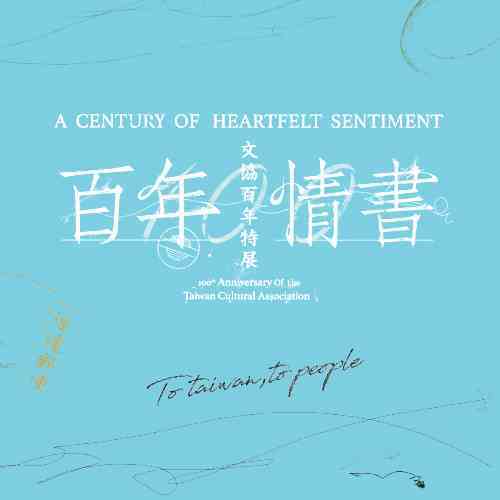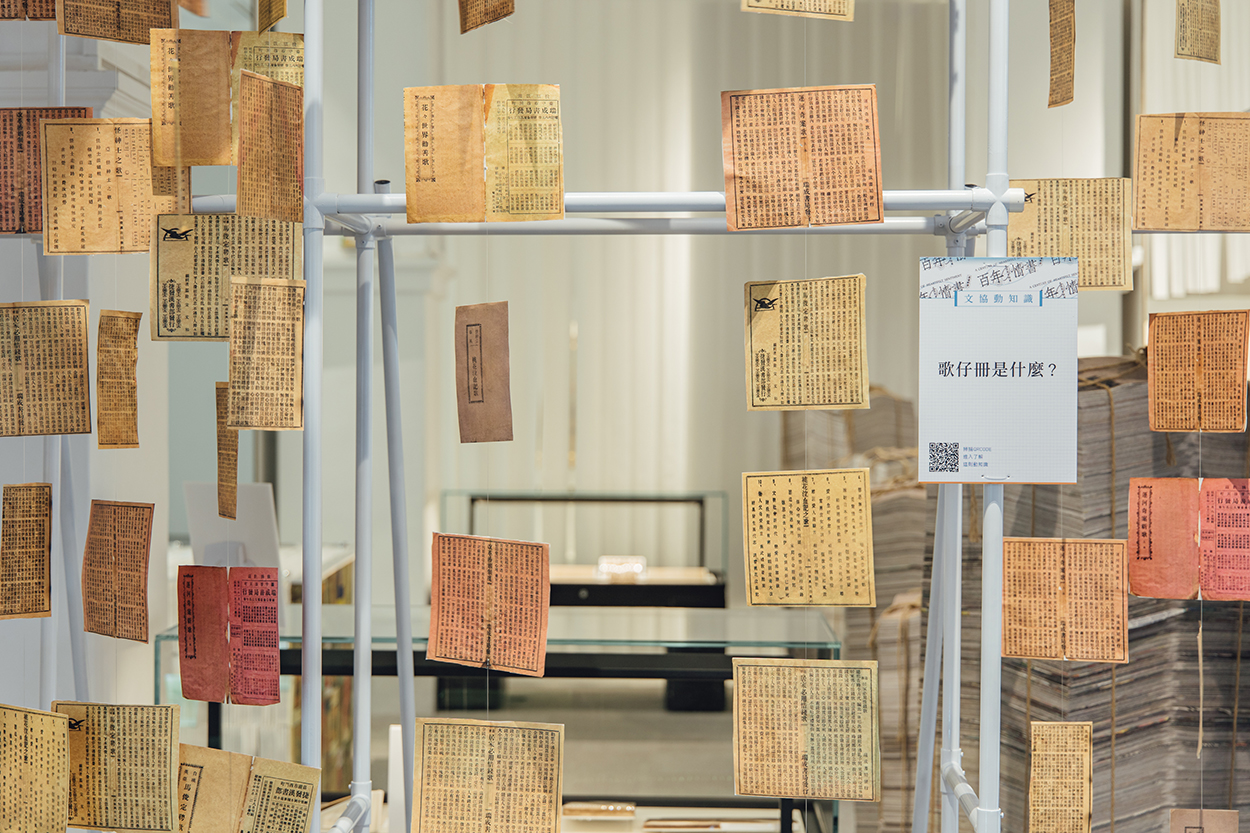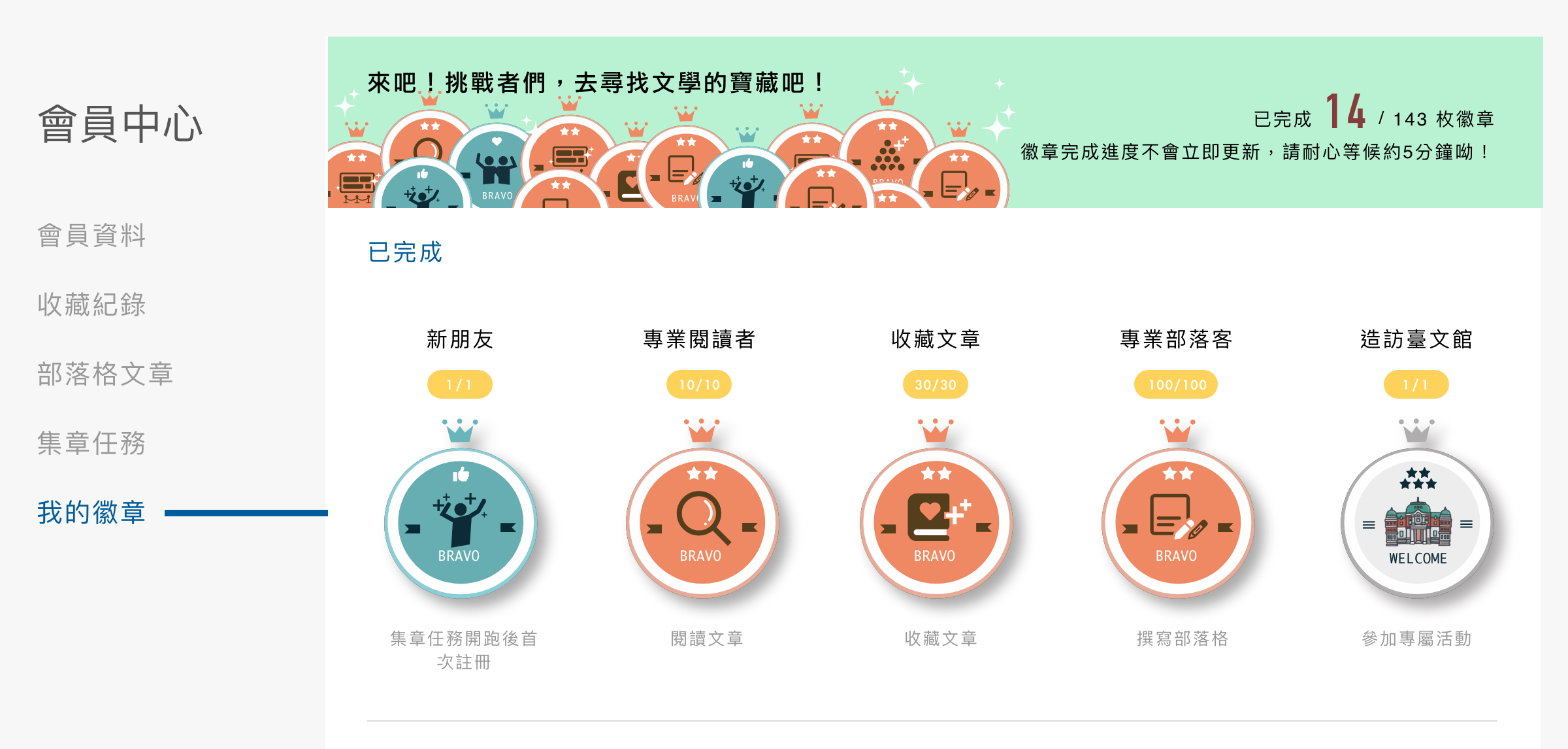Portraying 'You' in Lines and Colors. Illustration Activities of the Taiwan Literature & Art Union|With Society in Sight and Mind. The 1930s Folk Literature Movement|Heartfelt Feelings Shared at the Speed of Sound. Music & Live Performance in the 1930s|Fixated on the Limelight. Performance Theater in Pre- and Postwar Cultural Movements
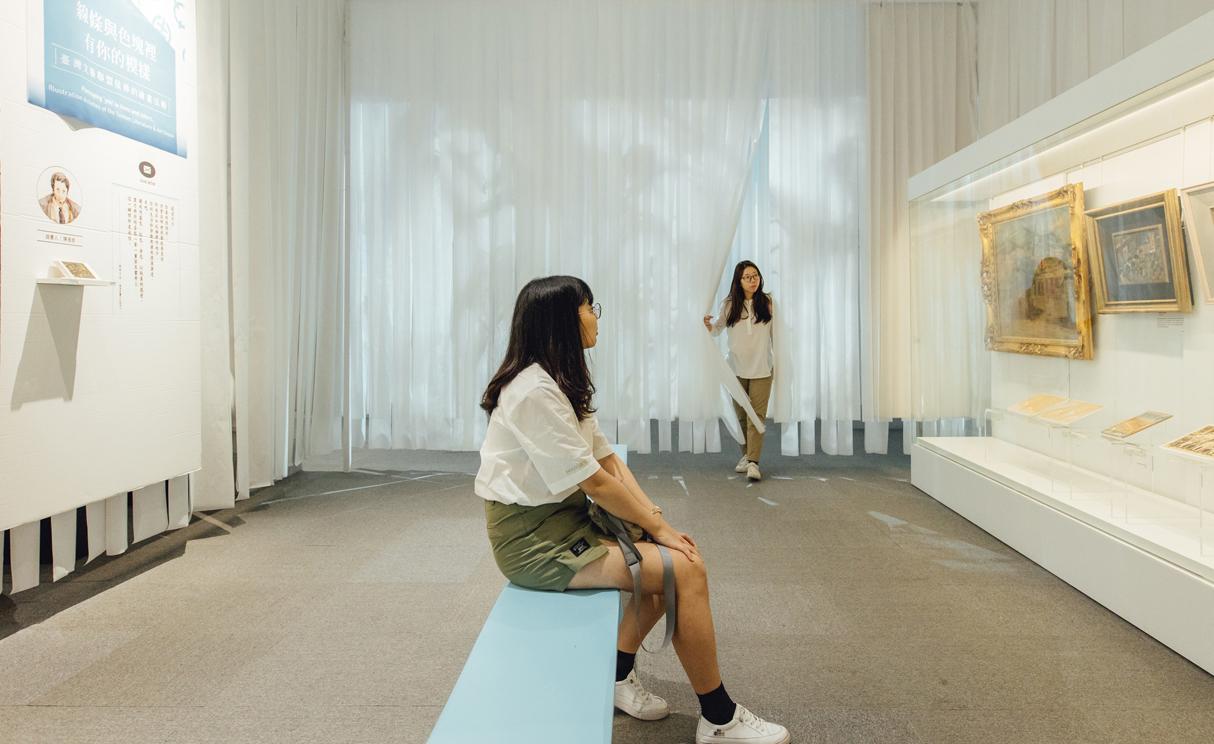

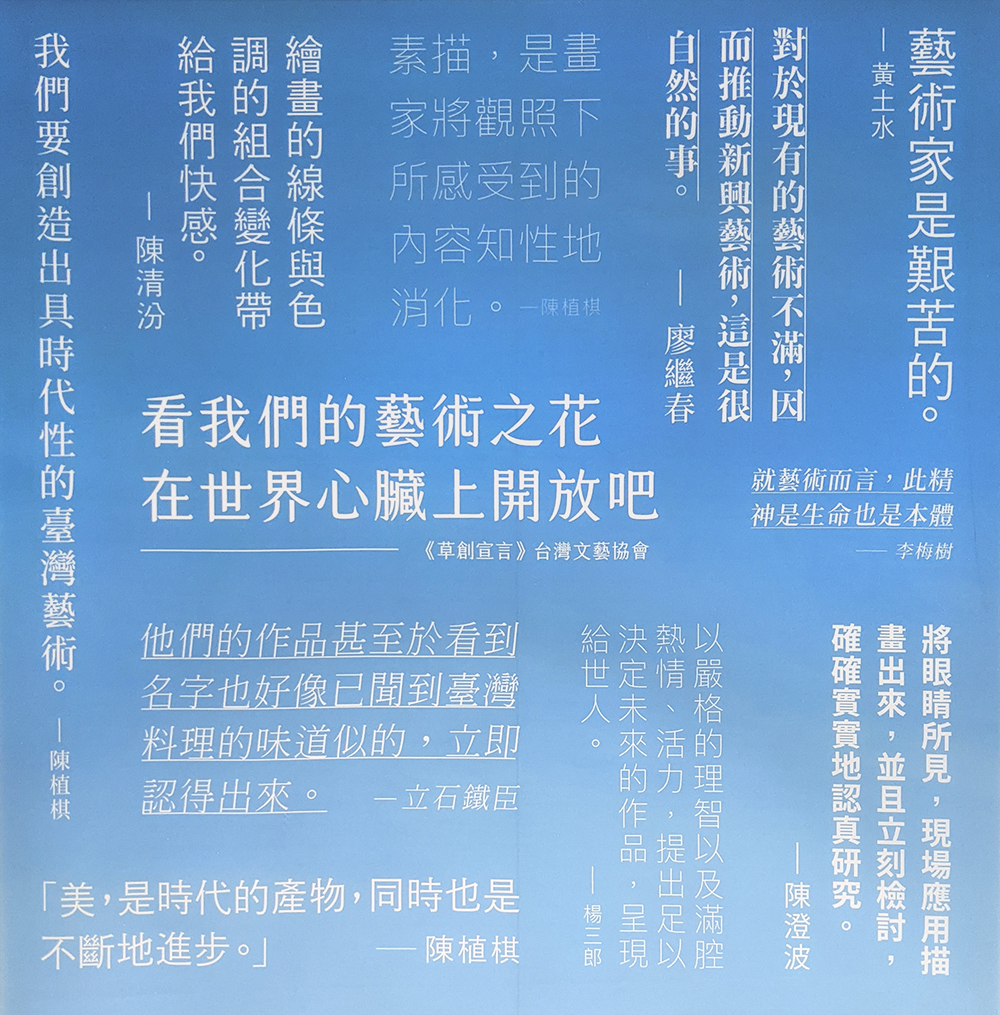 In the 1930s, fine art, illustrations, music, and the theater were where society let off steam. Intellectuals engaged directly in society, listening to the voices of class, labor, and the everyday. Shifting away from pie-in-the-sky idealism, they now immersed themselves in the realities of contemporary life in Taiwan to create their works. The closeness of intellectuals and society during this period had no precedent.
In the 1930s, fine art, illustrations, music, and the theater were where society let off steam. Intellectuals engaged directly in society, listening to the voices of class, labor, and the everyday. Shifting away from pie-in-the-sky idealism, they now immersed themselves in the realities of contemporary life in Taiwan to create their works. The closeness of intellectuals and society during this period had no precedent.
The Tokyo Taiwan Art Research Society, an organization founded in 1932 by Taiwanese students in Japan, published the flagship issue of their journal FORMOSA in 1933. The publication's manifesto stated: "Inspired by ideas and passions welling up from our hearts, we have chosen to create new literature and art that fits the proclivity and needs of true Taiwanese. We are highly motivated to create once again a distinctive Taiwanese Literary and Art genre." This manifesto told readers of the society's intent to introduce a literary stream fed by folk songs and stories. Creating body of literature wholly nourished by folk culture had never been tried before in Taiwan.
In 1934, Zhang Shen-qie, Lai Ming-hong, and other Taiwanese authors founded the Taiwan Literature & Art Union (TLAU) under the motto: "See the flower of our art unfurl in the bosom of the world!" TLAU member and ardent Hokkien-language advocate Liao Han-chen was a pioneer in adapting heritage stories and historical events to modern literary works. The literary and cultural movements during this decade worked to broaden the scope and deepen the cultural content of Taiwanese literature, inviting all to join in this process of creating the new Taiwan art and literary scene.
Our ancestors' purest legacy can be found only in Taiwan's folk literature. We are obligated to not only preserve it, but also organize it from the perspective of folklore……Others also bear the responsibility for helping with this matter. We hope everyone continues to work in this area—collecting songs, riddles, legends, and stories—and publish these as much as possible.

✒ Portraying 'You' in Lines and Colors. Illustration Activities of the Taiwan Literature & Art Union
On May 6th, 1934, the Taiwan Literature Alliance was founded. Taiwanese painters were finally able to be on an equal footing with Japanese painters after the Taiwan Art Exhibition and Japan Fine Arts Exhibition. Painters expressed their viewpoints about art through TAIWAN ART. The covers and illustrations they made reverberate with the writers' words. Liao Chi-chun's "My Attitude Toward Art," Chen Cheng-po's "Some Thoughts," Lee Shih-chiao's "My Thoughts Recently," Yan San-lang's "My Feelings About Creating Art," and Yen Shui-lung's "Questions about Sketching" all reflect the painters' sense of melancholy and of feeling adrift in the face of a ruthless society.
These emotions were the power expressed by the painters. The miners, street views, everyday food, people's postures, gazes, and expressions they painted reflect their rich understanding of society. Yen Shui-lung dedicated himself to crafts, while Chen Cheng-po devoted himself to art school. Working on the frontlines, they created art with a romantic and practical style.
____.¸¸.¤·.¸¸.·´¯`·.¸¸.¤ ღ ¤·.¸¸.·´¯`·.¸¸.¤·.¸¸.____
Dear,
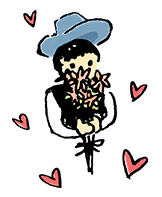 You're really special. I can spot you everywhere you go, even in a crowded place like this. Your life and hard work attract me deeply. Come, let me paint every trace of you on the canvas in blue, red, and yellow with my most genuine feelings. This moment shall stay forever.
You're really special. I can spot you everywhere you go, even in a crowded place like this. Your life and hard work attract me deeply. Come, let me paint every trace of you on the canvas in blue, red, and yellow with my most genuine feelings. This moment shall stay forever.
Reference: Chen Cheng-po's CROWD.
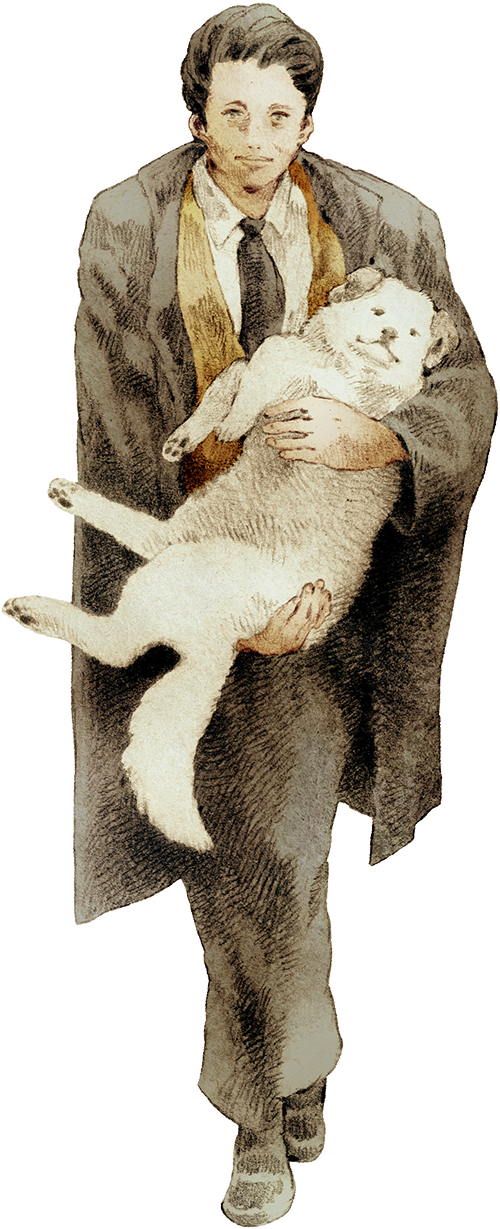
📪️ Chen Cheng-po(1895—1947), born in Chiayi. When he was studying at the Language School, he was the student of Kinichiro Ishikawa. He graduated from the Teacher Training Department of Tokyo Art School. He once worked for Chiayi First Public School, Shanghai Xinhua Art Vocational School, Chang Ming Art Vocational School.
In 1926, his work OUTSIDE CHIAYI STREET was featured in the 7th Empire Art Exhibition, making him the first Taiwanese Western-art painter whose work was featured in this prestigious exhibition. In 1933, he returned to Taiwan from Shanghai and established the Taiyang Art Association with his painter friends. After the Second World War, he planned to found an art school. In 1946, he was elected as a member of the first Chiayi City Municipal Representative Council. He died during the 228th incident.
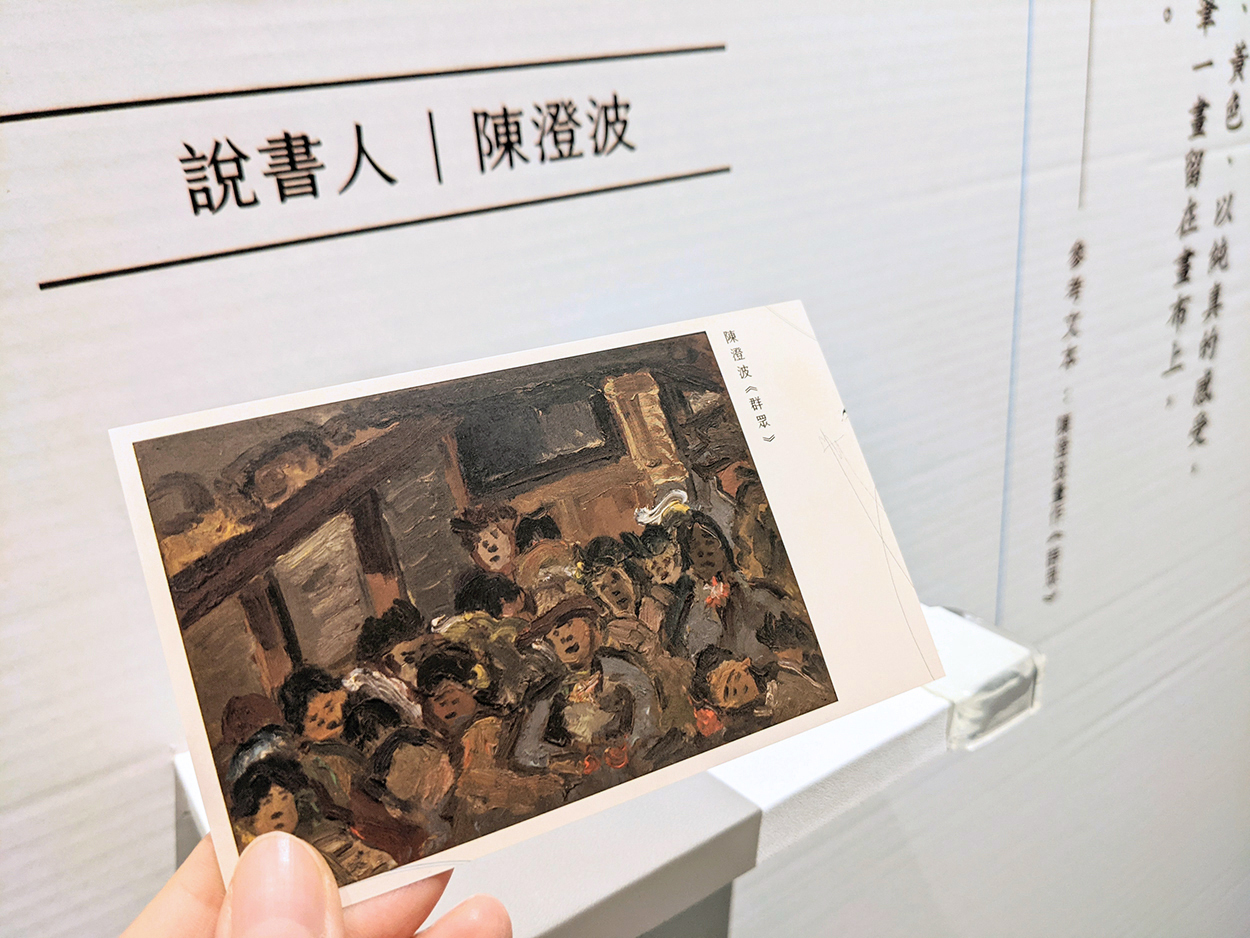
We observe ourselves, study ourselves, understand our own merits and demerits, and walk toward the right path. This may be said to be the most important thing! We must not act bossy. Instead, we should explore new worlds tirelessly with vibrant energy.
—Chen Cheng-po, translated by Yen Chuan-ying, "Some Thoughts"
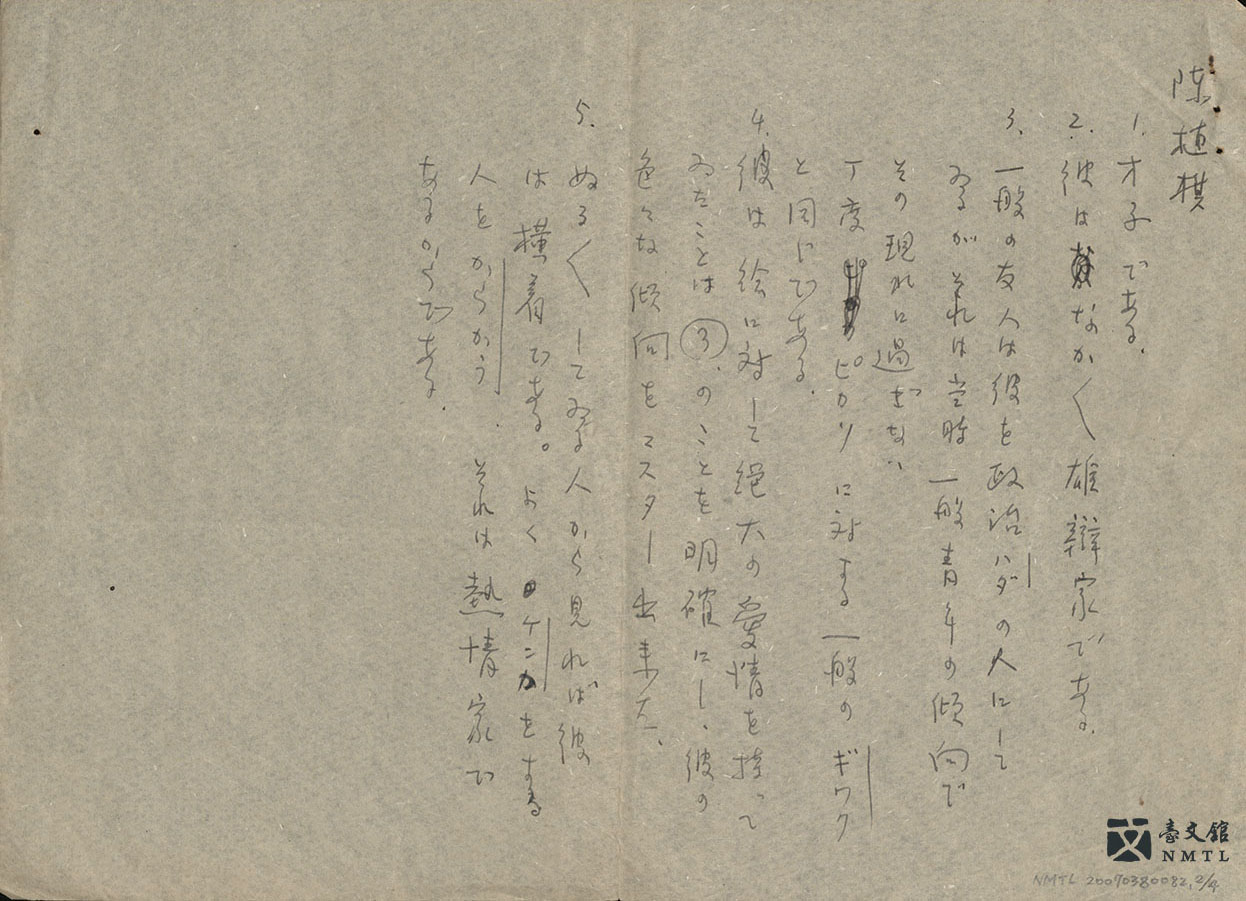
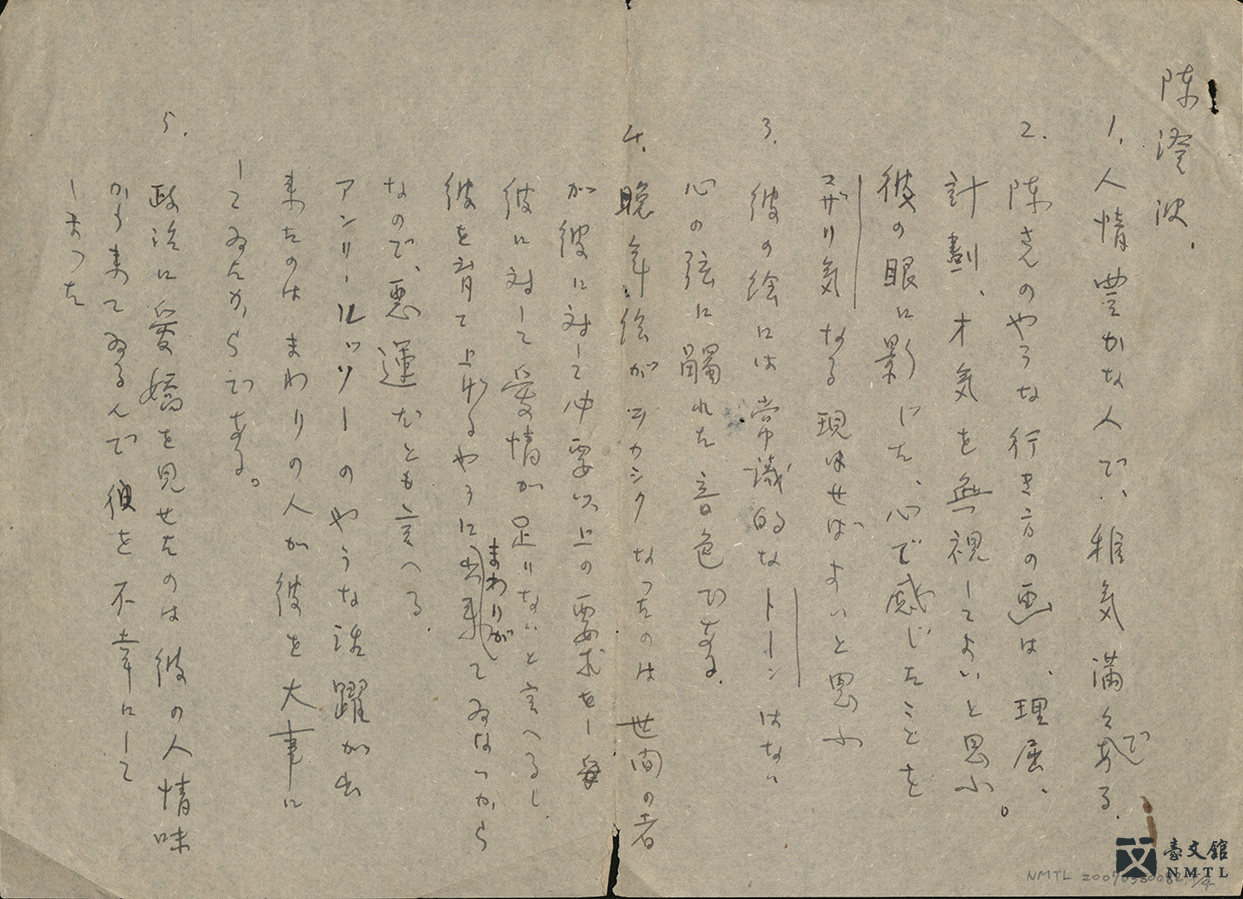
ღ Guo Shui-tan's "On Chen Zhi-qi, Chen Chun-de, and Chen Cheng-po"| Writer Guo Shui-tan, who specialized in writing about the salt production regions in western Taiwan during the Japanese Colonial Period, became a writer of general history after the war. In the 1940s, when he wrote CUSTOMS OF TAIWAN, he developed skills in field research and compiling historical records. At the beginning of the postwar period, many writers were faced with a huge language gap due to language replacement. Guo, who learned Chinese at a young age, seamlessly transformed from a young writer to a scholar of Taiwan history. In this manuscript, Guo concisely lists the characteristics of each painter. For instance, Chen Zhi-qi is a genius, a rhetorician, and has a great love for painting.(Donated by Guo Sheng-ping)
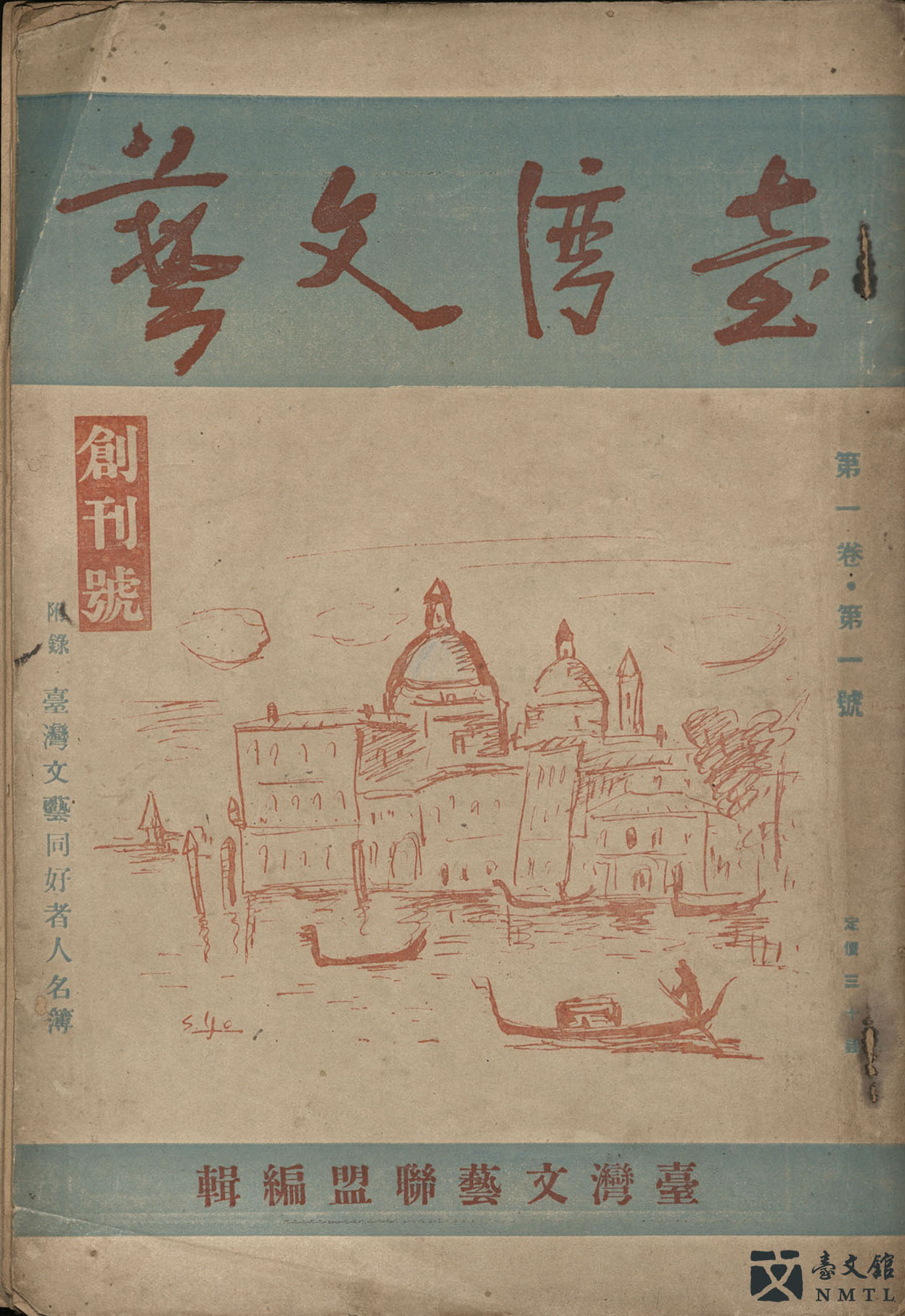
ღ First Issue of TAIWAN LITERATURE| On May 6th, 1934, Zhang Shen-qie and Lai Ming-hong founded the TAIWAN LITERATURE ALLIANCE. In November of the same year, the first issue of TAIWAN LITERATURE was published. The cover is Yang San-lang's sketch of Venice. TAIWAN LITERATURE connected people from the literary, art, and music worlds in the 1930s, bringing change to Taiwan's new literature movement.(Donated by Huang De-shi)
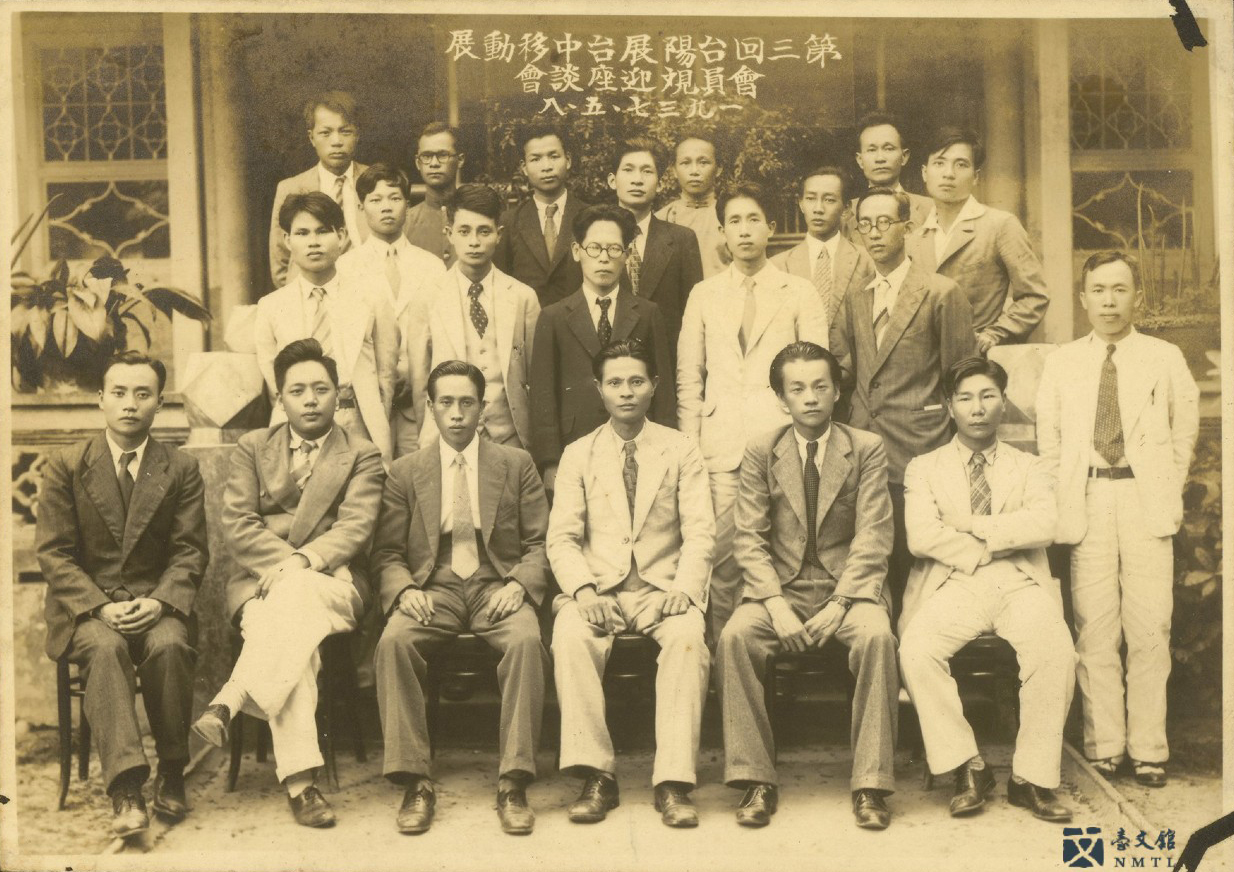
ღ The Opening Symposium of the third Taiyang Mobile Exhibition in Taichung| On May 8th, 1937, the Opening Symposium of the third Taiyang Mobile Exhibition in Taichung took place. First row, from the right: Hong Rui-lin, Lee Shih-chiao, Chen Cheng-po, Li Mei-shu, Yang San-lang, Chen De-wang; Zhang Xing-jian, Lin Wen-teng, Li Xiang-zhang, Yasuo Tanaka, Yang Kui; Wu Tian-shung, Zhuang Sui-xing, unknown, Ye Tao, Zhang Shen-qie, Wu Yong-fu, and Zhuang Ming-cheng.(Collection of Archives of Institute of Taiwan History, Academia Sinica)
➹ Cultural Association Q&A
Q: On May 3rd, 1937, the third Taiyang Exhibition held by the Taiyang Art Association in Taipei Educational Hall had just ended. The members of the association came immediately to Taichung. Among the members in attendance, who was the key person who connected the art circle with the literary scene?
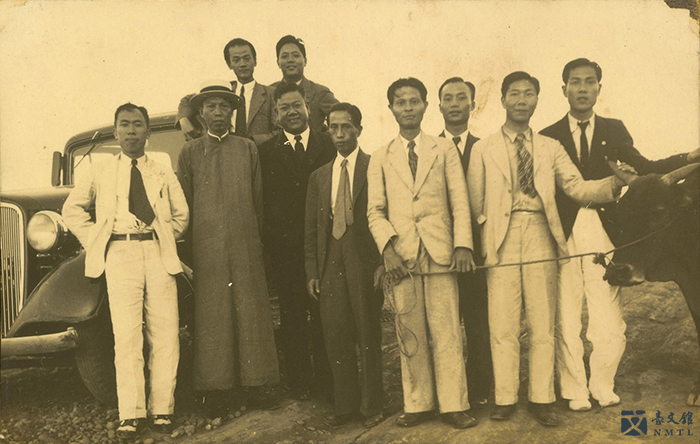
【Hint】 From May 8th to 10th, 1937 during the third Taiyang Mobile Exhibition, painters of the Taiyang Art Association travelled together with Yang Zhao-jia. Front row, from the right: Lu Ji-zheng, Hong Rui-lin, Chen De-wang, Chen Cheng-po, Li Mei-shu, Yang Zhao-jia, Anonymous, Zhang Xing-jian; front row, from the right: Yang San-lang, Lee Shih-chiao. (Figure: collection of Archives of Institute of Taiwan History, Academia Sinica)
#TaiyangArtAssociation #TaiwanLiteratureAlliance
A: Zhang Xing-jian. Zhang Xing-jian was Director of the Business Department of the Central Bookstore, a member of the Taiwan Literature Alliance, and the publisher and editor of TAIWAN ART. Before becoming the editor of TAIWAN ART, Zhang was a huge supporter of Taiwanese artists. For instance, he helped when Chen Cheng-po, a painter and member of the Taiwan Literature Alliance Chiayi Branch, held a seminar on Western art at Central Bookstore. When Lee Shih-chiao painted portraits for the parents of Wu Yong-fu and Loa Ho, Zhang was the one that introduced them to one another.
On the cover of TAIWAN ART and in its articles on Taiwanese art, the interaction between Taiyang Art Association and Taiwan Literature Alliance may clearly be seen.
There are two known photos from the third Taiyang Mobile Exhibition in Taichung in 1937. Although TAIWAN ART had already been suspended and Yang Kui had already founded TAIWN NEW LITERATURE after leaving Taiwan Literature Alliance, the close relationship between the art and literary worlds back then remains still visible today.
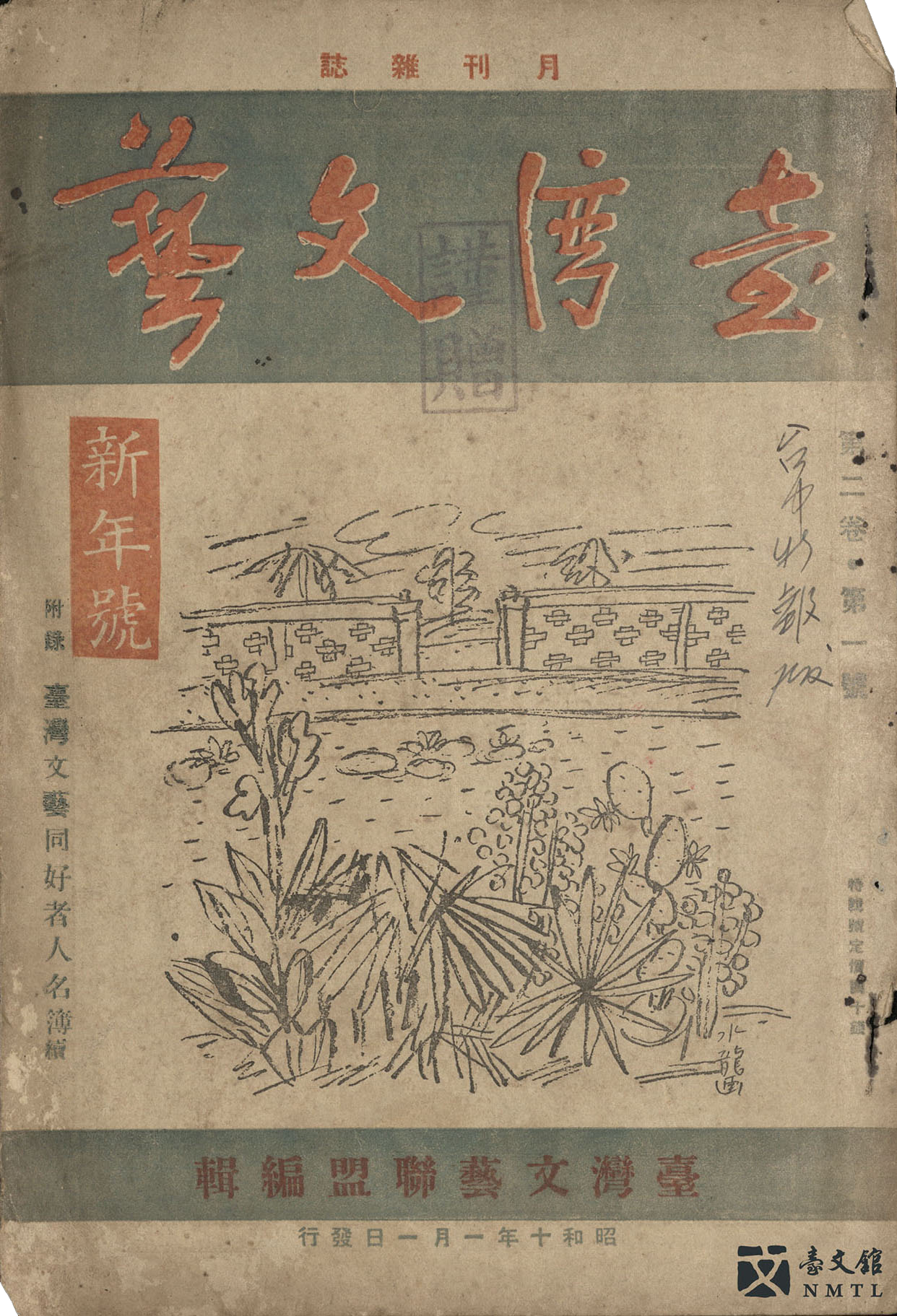
ღ No. 1, Vol. 2 TAIWAN LITERATURE—Cover by Yen Shui-lung| Apart from submissions from writers, TAIWAN LITERATURE also received submissions from painters who made illustrations for the cover and articles. TAIWAN LITERATURE Symposium (North) was held in 1934, the year that the alliance was founded. It touched upon topics of art, music, and dance. Yen Shui-lung had quite a few sketches at the time, which was his focus before he began working on crafts and living crafts.(Donated by the family of Zhou Ding-shan)
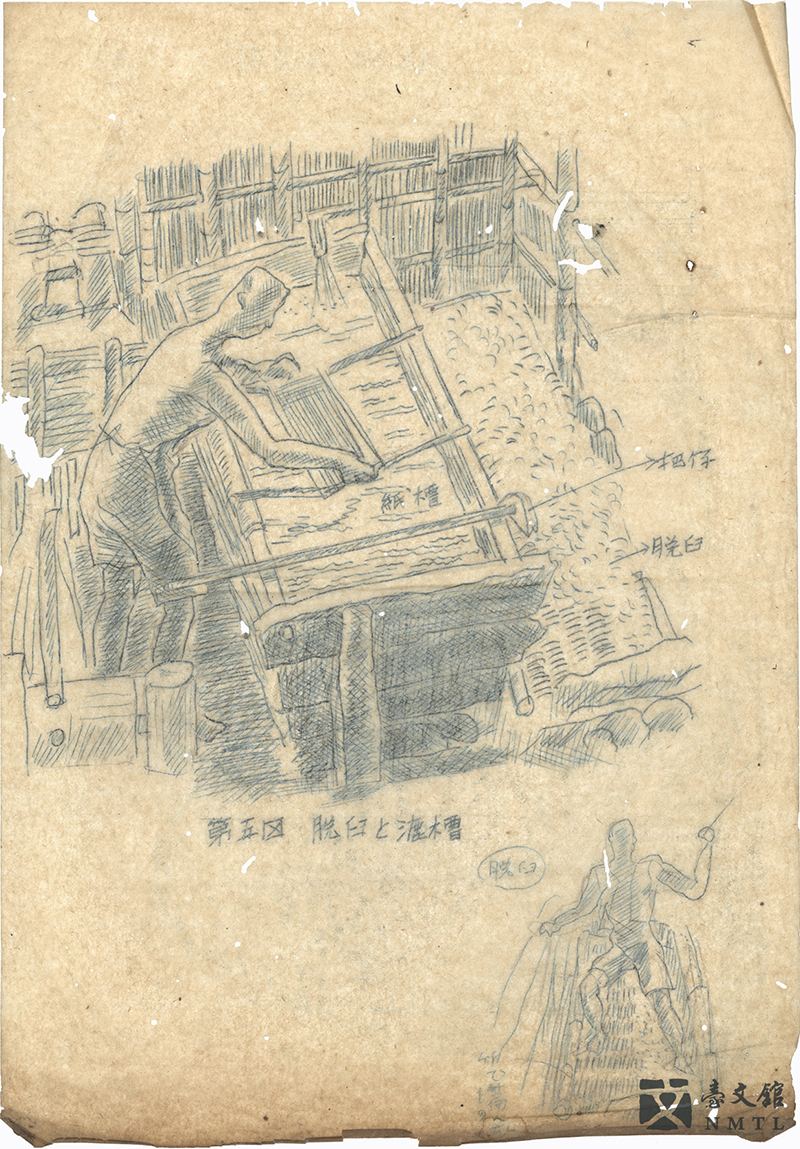
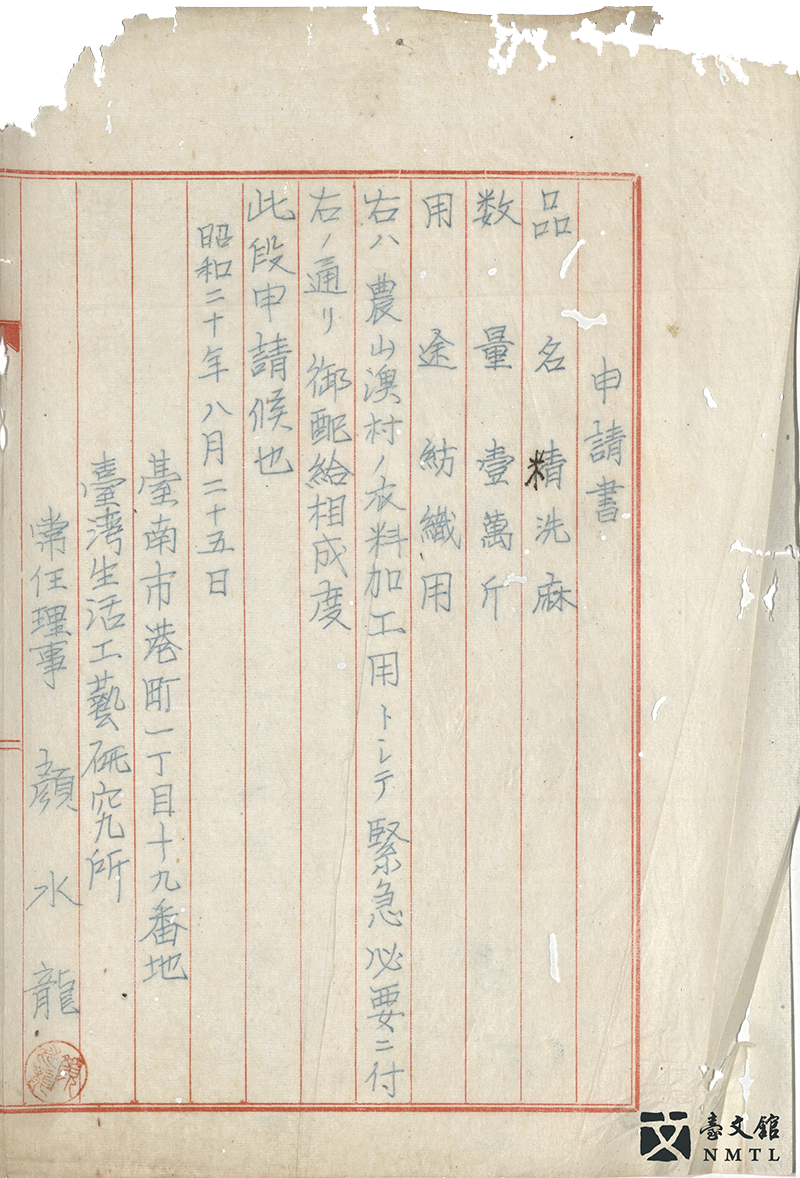
ღ Yen Shui-lung Drafts of Craft Techniques| This work is from the collection of Zhuang Song-lin. From Taiwan Literature Alliance from before the war to "Taiwan Living Crafts Center" organized after the war in the 1950s, Zhuang and Yen left important records of folk literature and living crafts with the written records and paintings they collected from their field research.(Provided by Zhuang Ming-zheng)
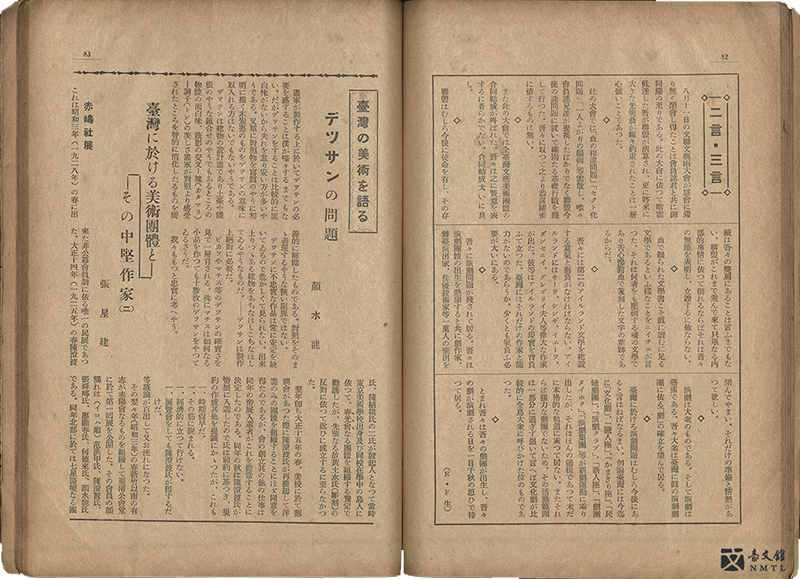
ღ No.10, Vol. 2 Taiwanese Art Groups and Prominent Artists TAIWAN LITERARY MAGAZINE, Zhang Xing-jian| In this article, Zhang Xing-jian introduces the White Cedar Society founded by Gôbara Kotô, a Taiwan-based Japanese painter specializing in Japanese art. Gôbara was a Japanese art painter and scholar. He thought the Taiwanese exhibition was unable to actively encourage artists with passion as it was only held once a year. Therefore, he founded the organization, aiming at holding an exhibition every spring to complement the Taiwanese exhibition in the fall. The exhibition attempted to increase artists' exposure. It also welcomed all criticism, hoping to expand the artists' horizons and the scope of their styles.(Donated by the family of Wu Shou-li)

✒ With Society in Sight and Mind. The 1930s Folk Literature Movement
In October 1935, Li Xian-zhang published A COLLECTION OF TAIWAN FOLKTALES. The book was composed of folk songs and stories he had collected over a three-year period. Yet, before the book was published, he was hospitalized due to overwork. Loa Ho understood his hard work and thus wrote down the meaning of collecting folktales from the common people on Li's behalf: "These stories and songs, although rejected by intellectuals, are still being told and sung by people today. This sort of vitality is something we dare not look down on. Why? Because every chapter, every story, and every song represent the customs, culture, politics, and systems at the time. They further represent the authentic thoughts and feelings of the people at the time. Therefore, they are worth preserving from the perspectives of folklore studies, literature, and even linguistics."
In the mid 1930s, the new literature movement continued. Intellectuals further debated about who the "audience" was: the hardworking lower class or all common people? This debate inspired a new way of thinking. Some people decided to change their target audience and pursue a unique style from the perspective of the common readers. In the 1930s, intellectuals like Li Xian-zhang were won over to the idea that "only common people who have not been corrupted can express their lives and ideas candidly." Folk and popular literature conveyed the feelings shared by everyone.
____.¸¸.¤·.¸¸.·´¯`·.¸¸.¤ ღ ¤·.¸¸.·´¯`·.¸¸.¤·.¸¸.____
Dear,
 Lately, you told me about the fascinating stories of "18 baskets" and "Lin Da Chian and His Sister," which changed my views about the pirate Lin Daoqian.
Lately, you told me about the fascinating stories of "18 baskets" and "Lin Da Chian and His Sister," which changed my views about the pirate Lin Daoqian.
You said everyone in the neighborhood knew about these stories. I was surprised; I'd lived so long but knew nothing about these.
When I returned, I told my friends, Wang Shilang and Liao Han-chen about these stories and they were all very fascinated.
Next time, I want to listen to you tell the stories again so that I can record them and carry out some research. I think this is what I should do and can do.
Reference: Li Xian-zhang, A COLLECTION OF TAIWAN FOLKTALES.
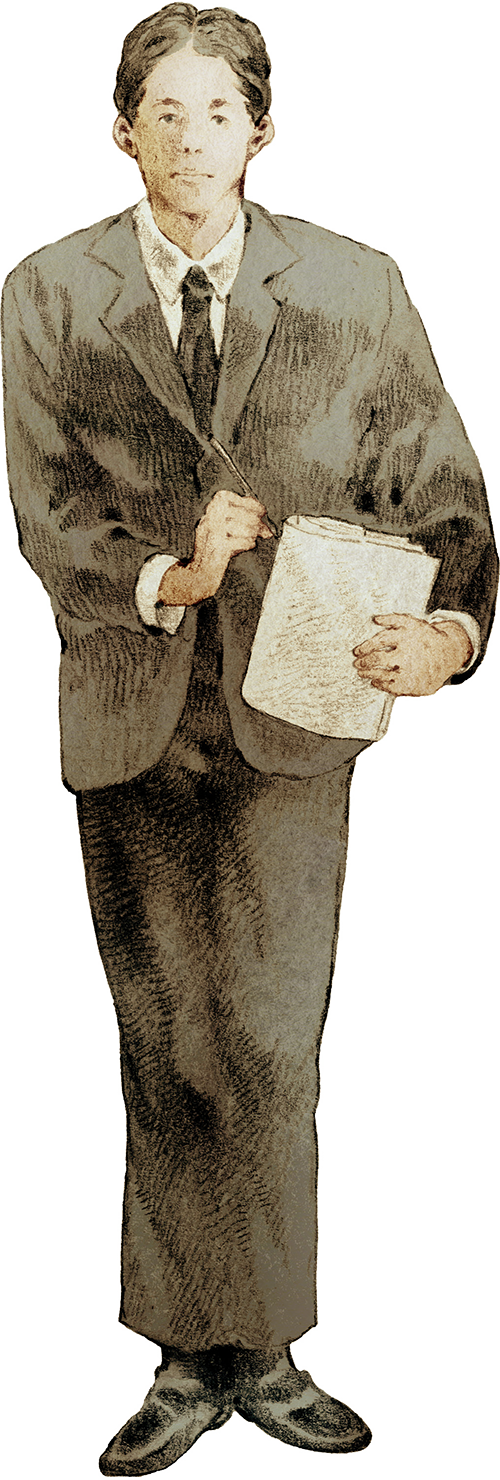
📪️ Li Xian-zhang(1914-1999), born in Daxi Taoyuan. He graduated from the Philosophy Department, College of Literature, Waseda University.
In the 1930s, due to his realization of the values of folk literature, Li Xian-zhang included folk stories in SOUTH SOUND and FIRST LINE. In 1934, he joined the Daxi Reform Society and edited the journal REFORM. In 1936, A COLLECTION OF TAIWAN FOLKTALES, which he edited and published, became his representative work. This book includes "the chapter of songs," covering folk songs, children's songs, and riddles, and "the chapter of stories," covering adaptations of folk stories that he collected from different places. After the war, he was hired as a lecturer and researcher at schools in Tokyo and Hong Kong.
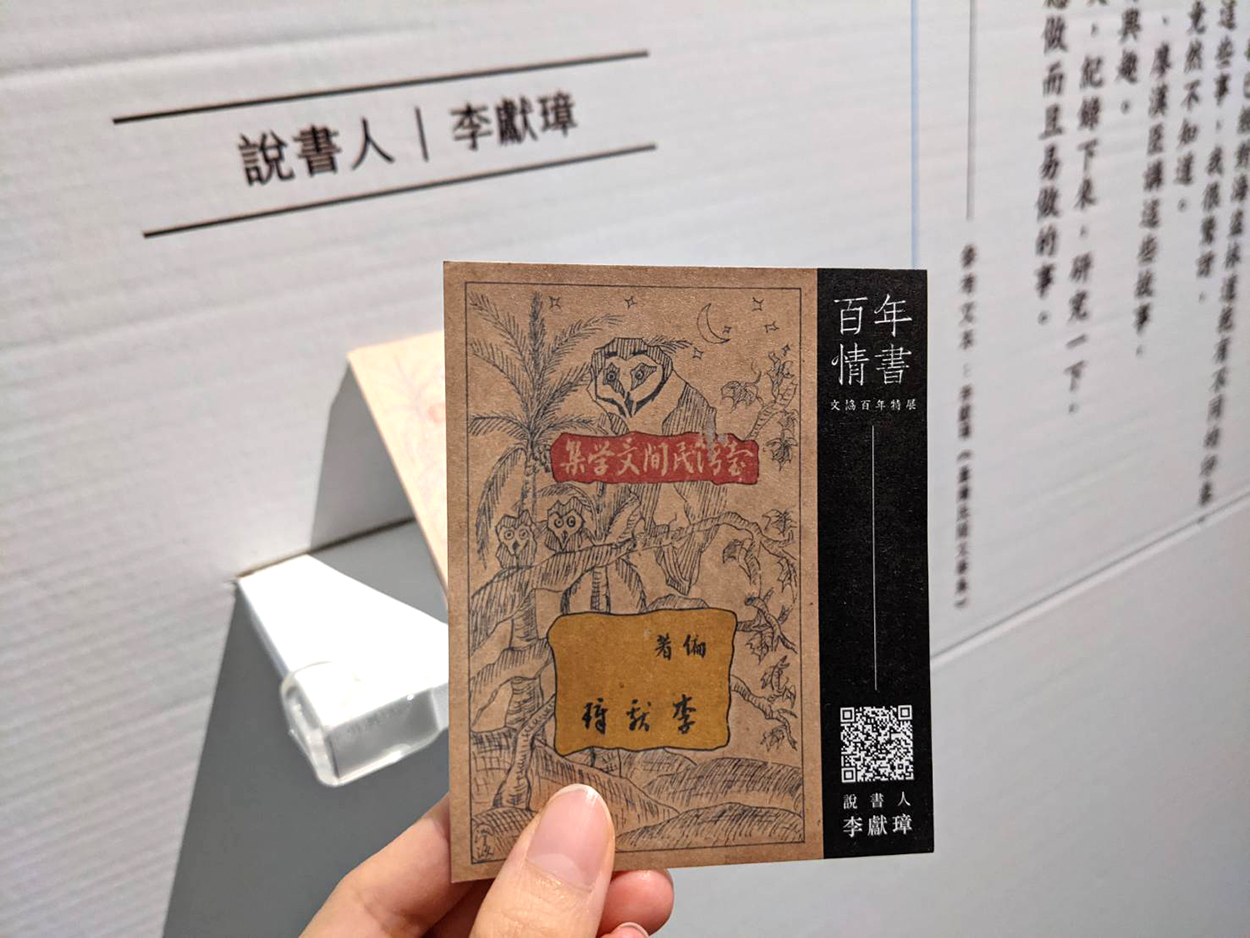
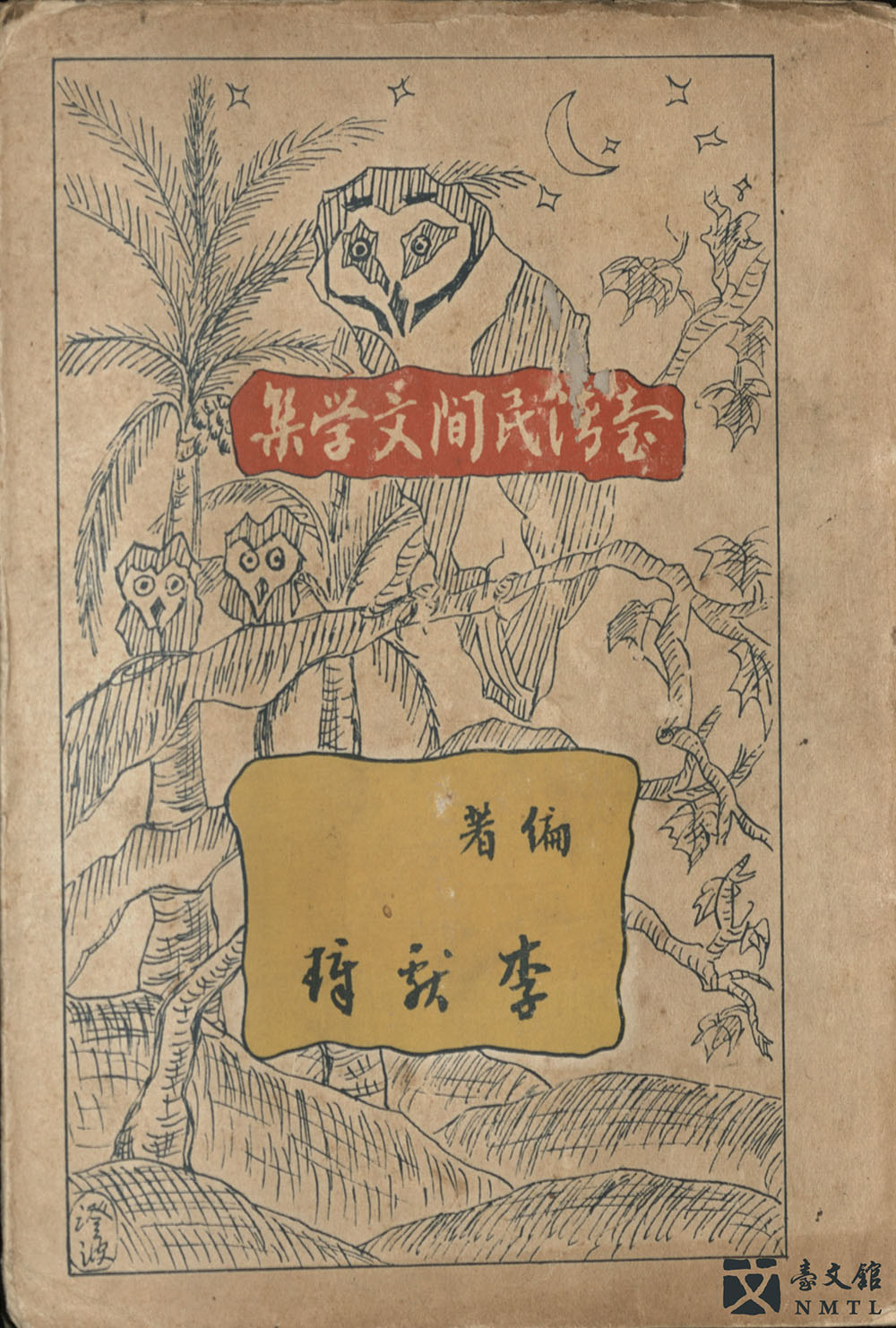
ღ TAIWAN FOLK LITERATURE edited by Li Xian-zhang| TAIWAN FOLK LITERATURE was published by Taiwan New Literature in April 1936. The book is divided into folk song and folk story sections, with the folk song section covering folk songs, nursery rhymes, and riddles. The story section includes 23 legendary stories written by 14 writers such as Loa Ho, Liao Han-chen, and Yang Shou-yu. Loa Ho's foreword indicates that every folk song or story represents the culture, traditions, and politics at the time, as well as the ideas and emotions of the general public.(Donated by Lin Rui-ming)
➹ Cultural Association Q&A
Q: In A COLLECTION OF TAIWAN FOLKTALES, what is the story behind the removed tale "Mystery in the Mist"?
A: "Mystery in the Mist," written by Yang Shou-yu, illustrates the tale of how the fifth generation of the Lin Family in Wufeng during the Qing Dynasty died in front of a tribunal. According to YANG SHOU-YU'S DIARY, after the book was published, Li Xian-zhang received a letter from Lin Zi-xiu that claimed the story was apocryphal. However, Yang thought he was only recording what he had heard and he had not altered the story as conveyed to him. As neither was able to travel, they did not meet. Thus, Yang Kui, Loa Ho, and Li Xian-zhang acted as mediators between the two.
In the end, Li Xian-zhang removed "Mystery in the Mist" from the book. When Yang heard about it, he wrote in his diary to express his discontent: "Xian-zhang is a remarkable person. I wonder if he still remembers that he especially asked me to write down this story himself?"
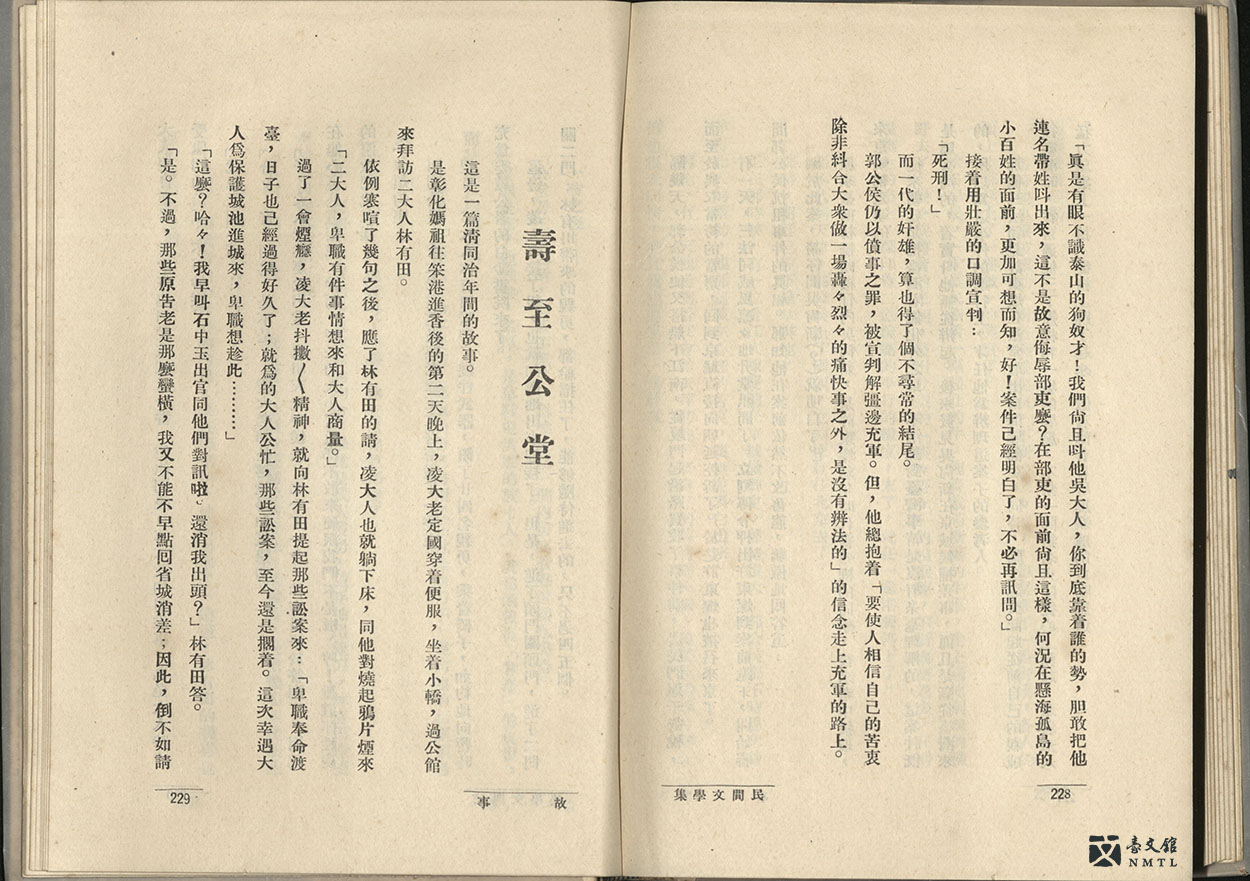
ღ Yang Shou-yu "Mystery in the Mist," A COLLECTION OF TAIWAN FOLKTALES| Yang Shou-yu wrote "Mystery in the Mist" based on the local legends he collected. It tells the story of the fifth generation of the Lin Family in Wufeng being threatened with death after "plotting a revolt" and "usurping others' land." The story was included in A COLLECTION OF TAIWAN FOLKTALES. However, it upset the Lin clan, and thus the story was removed. This copy of A COLLECTION OF TAIWAN FOLKTALES is a rare first edition.(Provided by the family of Li Xian-zhang)
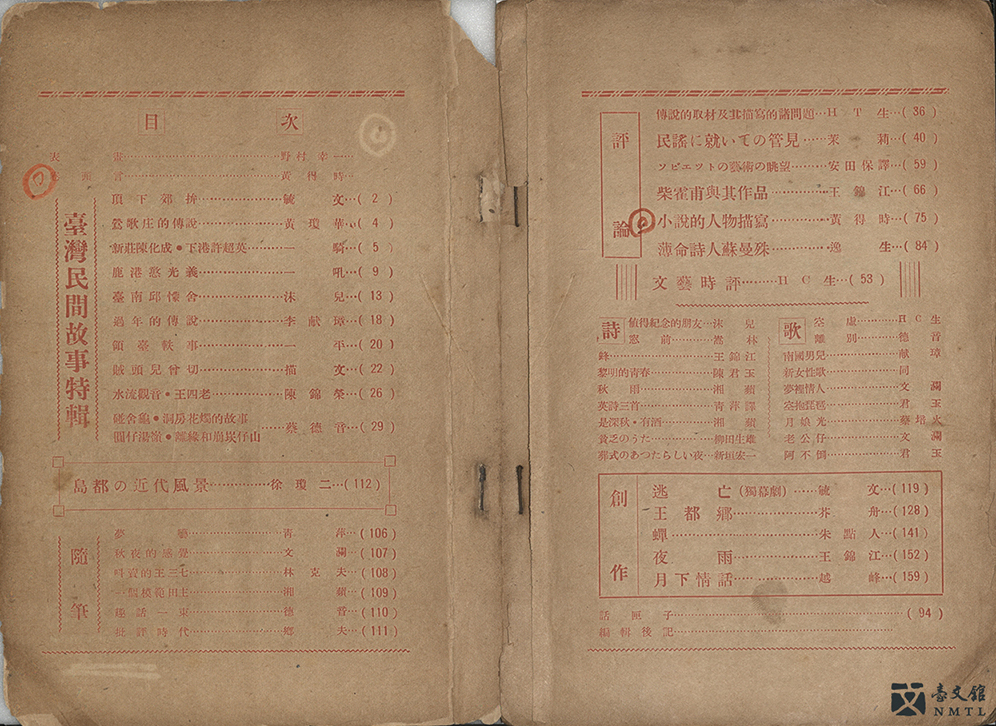
ღ "Special Feature: Taiwan Folktales" FIRST LINE| STARTING TROOPS was released on January 6th, 1935. The second issue was renamed First Line. Huang De-shi wrote in the introduction "Understanding Folk Literature" that Taiwanese people generally cared and knew little about folk literature, and thus there was a lack of legends being collected. As a result, FIRST LINE launched the "Special Feature: Taiwan Folktales" and published folktales and legends collected by Liao Yu-wen, Li Xian-zhang, Chen Jin-rong, and Cai De-yin from across Taiwan (Monga, Yingge, Tainan, and elsewhere) The themes included local history, legendary figures, and lunar new year traditions.(Donated by Huang De-shi)
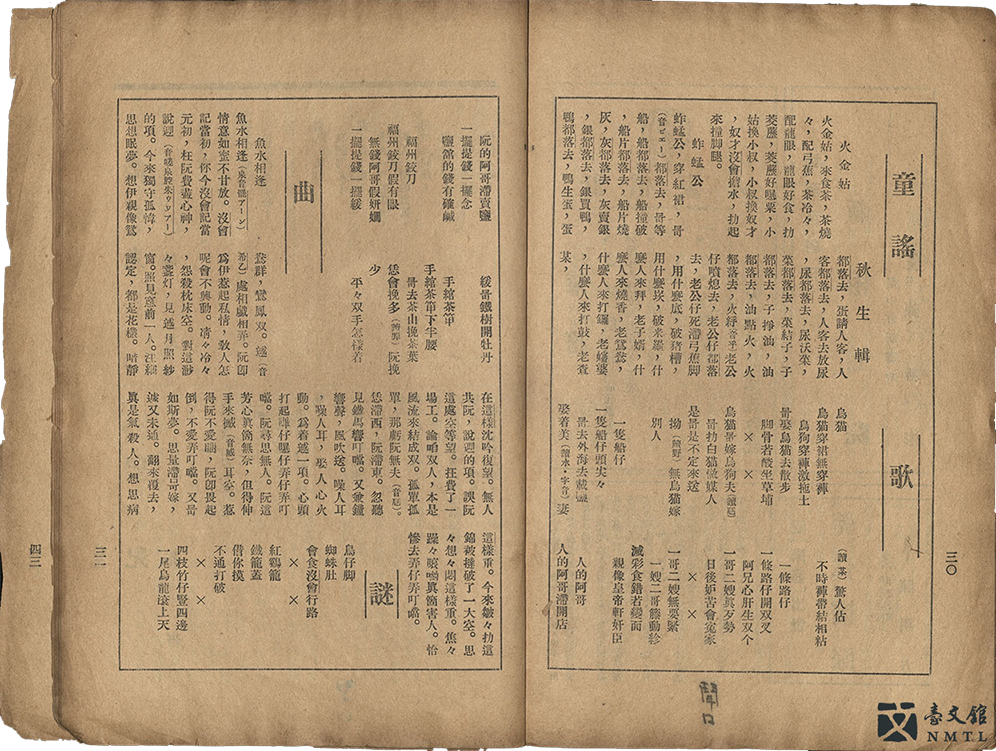
ღ Nursery Rhymes—Songs, Tunes, and Riddles, No. 2, Vol. 1, SOUTHERN VOICE| SOUTHERN VOICE was founded in February 1932, when Taiwanese opera and Taiwanese pop songs were popular. The foreword of the first issue says: "To make literature and art deeply rooted in people's hearts is a goal of our magazine." No. 2 of Vol. 1 features nursery rhymes, songs, tunes, and riddles, resonating with the daily entertainment of the general public.(Donated by Huang De-shi)
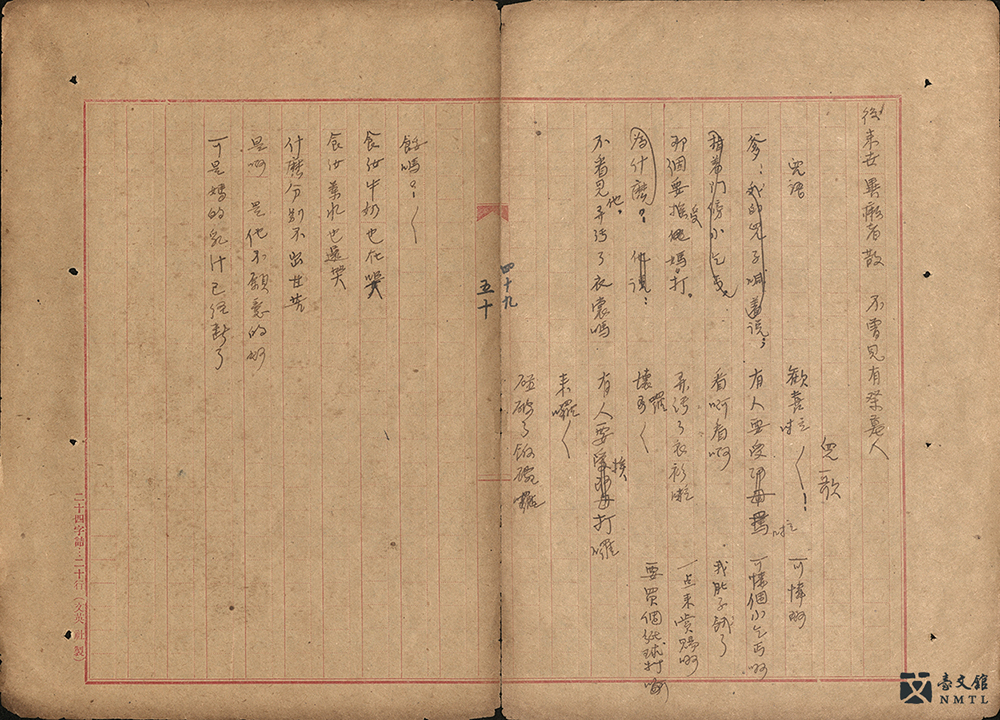
ღ Loa Ho "Children's Song"| Among the existing manuscripts of Loa Ho, there is one titled "Children's Song;" it is unclear when it was written.
Rejoice, rejoice! Somebody's getting scolded/ Look, look! The clothes are soiled/ Bad, bad! Someone's getting spanked/ Come, come! The bowl is broken/ Sad, sad! Little beggar/ I'm hungry, give me some money, I'm gonna buy a paper ball.(Provided by Loa Ho Education Foundation)
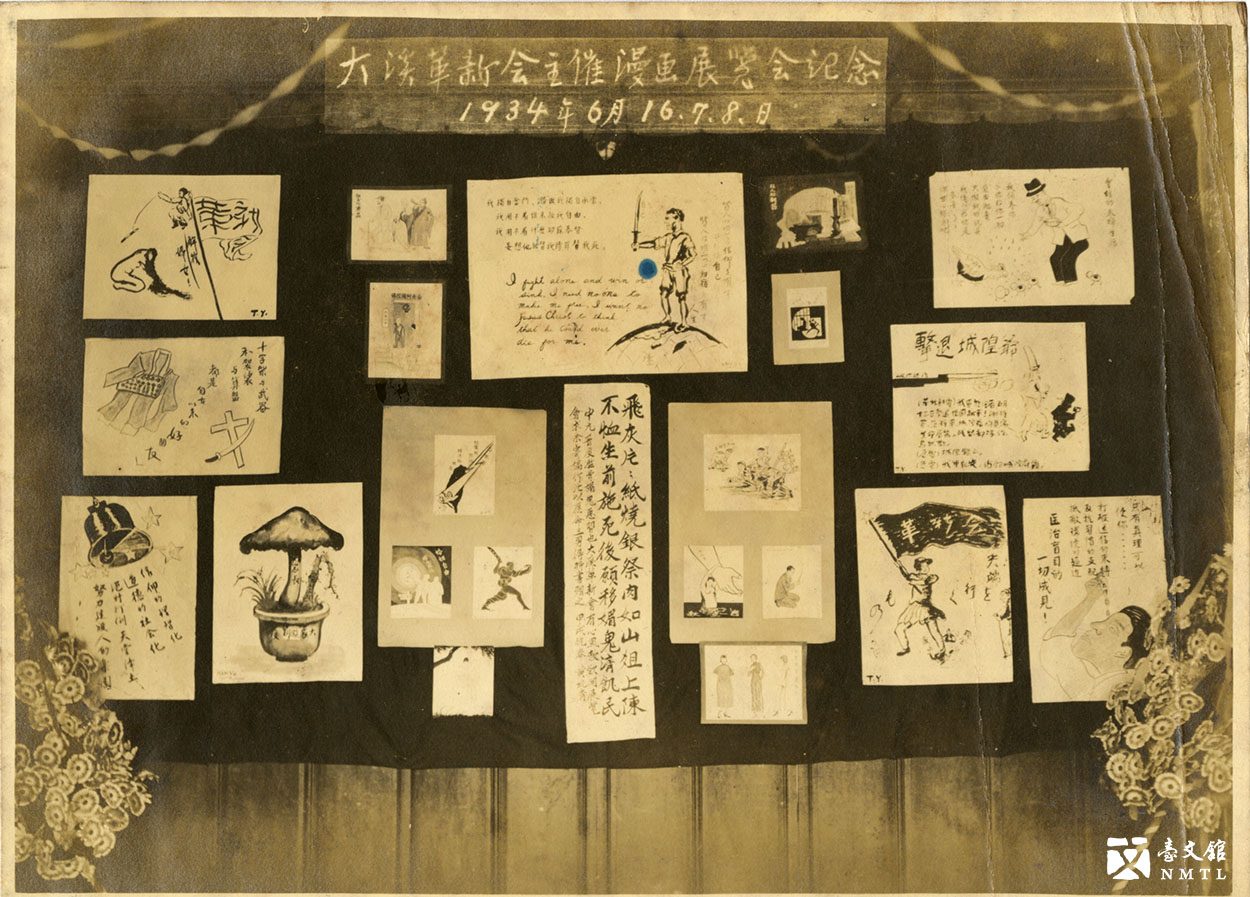
ღ Manga Exhibition Held by Daxi Reform Society | From 16th to 18th, in June 1934, Daxi Reform Society held a manga exhibition. This was a rare manga event during the Japanese Colonial Period. The mangas on display were written with words like "Reform," "Fight Against City God," "Women's Emancipation," and "Combat Senseless Prejudice," which resonated the Daxi Reform Society's aims of fighting superstition and eradicating corrupt traditions.(Provided by the family of Li Xian-zhang)
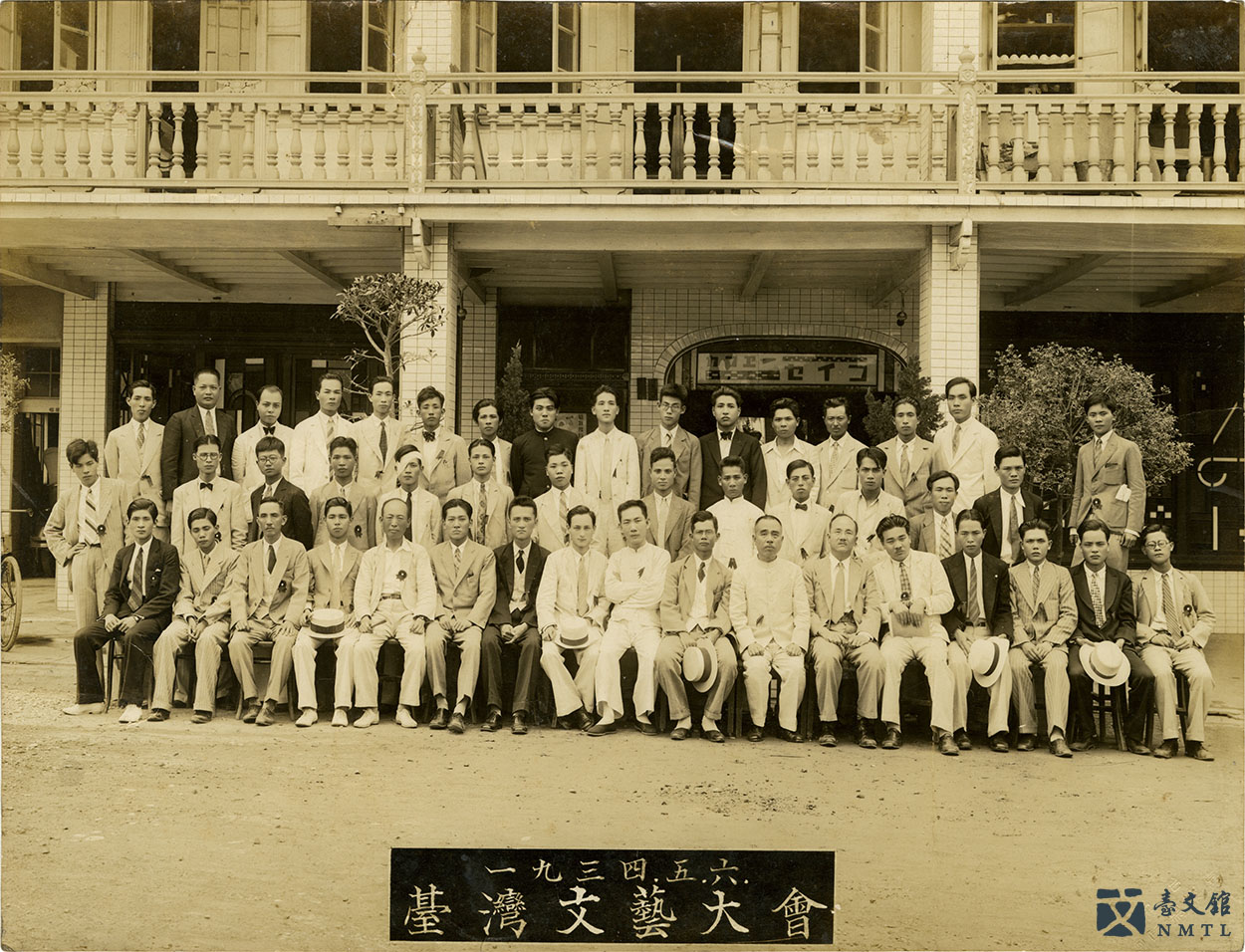
ღ Group Photo of the Taiwan Literature Meeting in 1934| Zhang Xing-jian and his good friends Zhang Shen-qie and Lai Ming-hong discussed about "how Taiwanese literature could be established," which encouraged them to hold a meeting for writers across Taiwan. On May 6th, 1934, the first Taiwan Literature Meeting was held and the "Taiwan Literature Alliance" was founded. More than 80 people attended the event from across Taiwan.
First Row: Zhang Shen-qie (first from the left), Lin Wen-teng (third from the left), Zhou Ding-shan (ninth from the left), Lin Hu (tenth from the left), Huang Chun-qing (eleventh from the left), and Zhuang Ming-dang (first from the right); Second Row: Zhang Wei-xian (sixth from the left), Guo Shui-tan (tenth from the left), Zhao Lima (eleventh from the left), and Zhang Xing-jian (third from the right); Third Row: Liao Han-chen (sixth from the left), Chen Chun-yu (seventh from the left), Huang De-shi (eighth from the left), Cai Qiu-tong (thirteenth from the left), and Li Xian-zhang (second from the right).(Provided by the family of Li Xian-zhang)
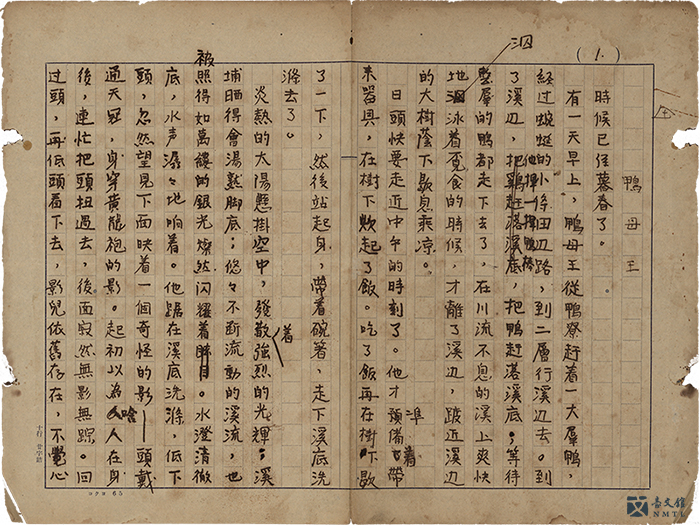
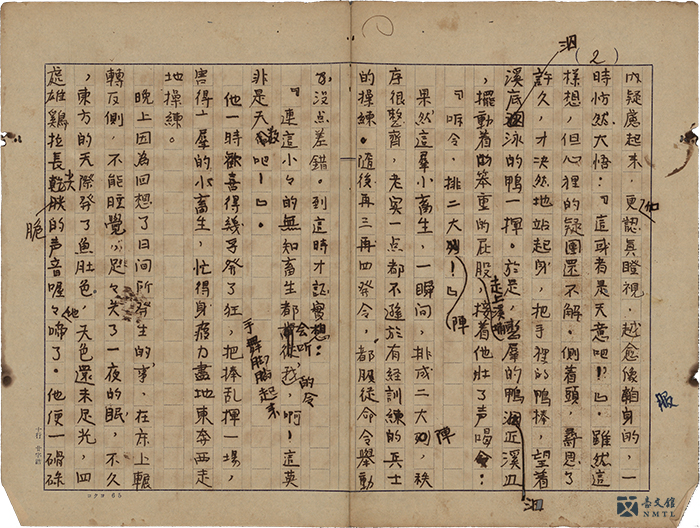
ღ Zhuang Song-lin "Zhu Yigui"| Many folk legends about Zhu Yigui were collected by Zhuang Song-lin. They were adapted into "Zhu Yigui" and included in TAIWAN FOLKTALES. The story takes the perspective of the common people and describes how unrest happens due to oppression by officials and it is an act of God's will. In terms of language, it consists of many Taiwanese idioms. There are even roman letters used in the transcription, which to some extent reveals Zhuang's stance.(Provided by Zhuang Ming-zheng)
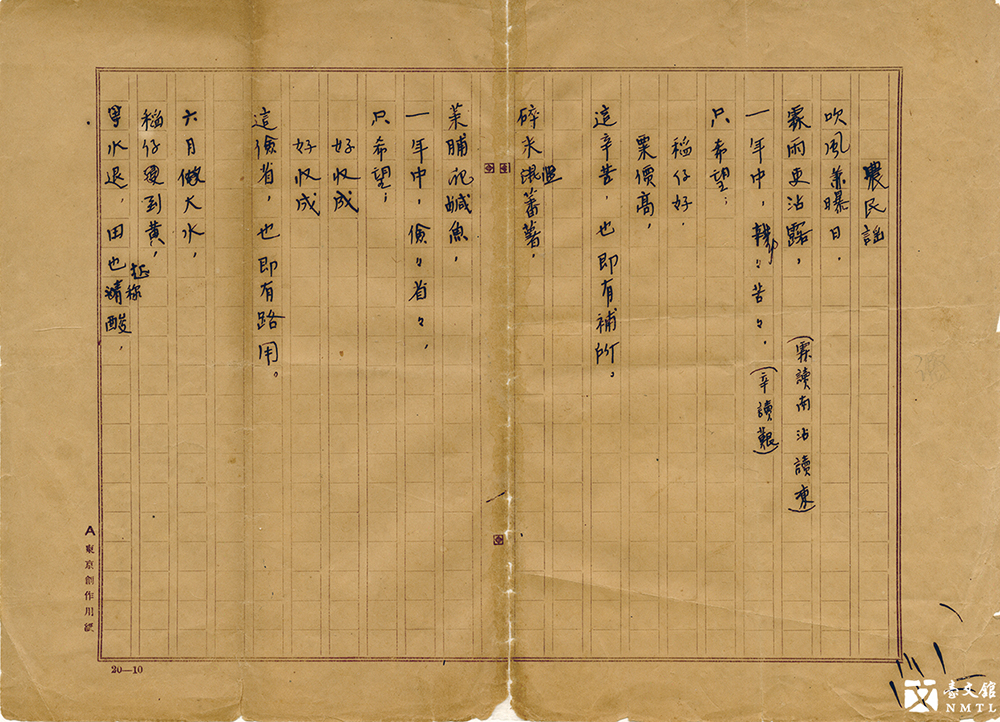
ღ Loa Ho "Farmers' Song"| On January 1st 1931, Loa Hoa published his "Farmers' Song" under the name of Fusang in TAIWAN HSIN MIN PAO, together with the numbered musical notation made by Li Jintu. In one parenthesis of the manuscript, the sentence "霖讀南 沾讀東 辛讀艱" , shows how to read some of the words, "霖", "沾", "辛" are read as same as the words "south" (南), "east" (東), "hard" (艱) in Taiwanese, respectively. Thus, this suggests that "Farmers' Song" should be read and sung in Taiwanese.(Provided by Loa Ho Education Foundation)

✒ Heartfelt Feelings Shared at the Speed of Sound. Music & Live Performance in the 1930s
▍Women and Music
Art is the best medicine for the wounds of our society. It is also a way of promoting Taiwan to the world. Lin Hau, a musical talent in the early 20th century, met and married Lu Bing-ding, a member of Taiwanese Cultural Association. Lin Hau was attracted to art music and thus went to Japan for vocal music training. She was immersed in the world's latest trends, bringing much impetus to Taiwan's cultural movements. However, Lu Bing-ding was arrested in 1932. In order to make a living, Lin Hau signed with Columbia Records, a large pop-music record label. Chun Chun was one of her famous contemporaries at Columbia Records. Lin Hau, who was trained in vocal music, and Chun Chun, a Taiwanese opera singer, performed with their different vocal styles.
In April 1935, Hsinchu and Taichung were struck by a big earthquake. Tsai Pei-huo and others initiated a benefit concert for disaster relief across the island. They performed mostly Western music. Many female musicians such as Kao Chih-mei and Lin Qiu-jin gave fantastic performances. Lin Hau toured with Zheng You-zhong's orchestra. She sang the inspiring "Our Taiwan" and the soothing "The Melancholy Under the Moon" and "Farewell Poem" to alleviate the victims' pain. She also sang the art song "Heidenröslein" and Italian folk song "Funiculi-Funicula," giving the audience a brand new experience.
____.¸¸.¤·.¸¸.·´¯`·.¸¸.¤ ღ ¤·.¸¸.·´¯`·.¸¸.¤·.¸¸.____
Dear,
 Let's meet at the public hall and play the 78rpm record at home. Let me sing you songs like "Zhinü," "One Red Egg," and "Spring Lament." When you're feeling down, this is what I can do for you. Don't look down on these songs. The power of music can soothe our hearts. Let's sing at the top of our lungs for the recognition of Taiwanese songs.
Let's meet at the public hall and play the 78rpm record at home. Let me sing you songs like "Zhinü," "One Red Egg," and "Spring Lament." When you're feeling down, this is what I can do for you. Don't look down on these songs. The power of music can soothe our hearts. Let's sing at the top of our lungs for the recognition of Taiwanese songs.
Reference: Lin Hau, "Zhinü," "One Red Egg," and "Spring Lament."

📪️ Lin Hau(1907-1991), born in Tainan City. Her stage name was Lin Li-mei. A graduate of Tainan Xinlou Girls' School, she was once a music teacher at Tainan Third Public School and a day care worker at Tainan Second Kindergarten. Her husband Lu Bing-ding's participation in social movements forced her to quit her teaching job. She once organized the Tainan Women's Youth Association.
In 1932, she took part in a voice test at Columbia Records, leading to her career as a singer. She was a singer on both the Columbia and Taiping labels. Then, she went to Tokyo to learn from Toshiko Sekiya. After the Second World War, she and her daughter Lin Xiang-yun worked on nurturing Taiwanese music and dance talents.
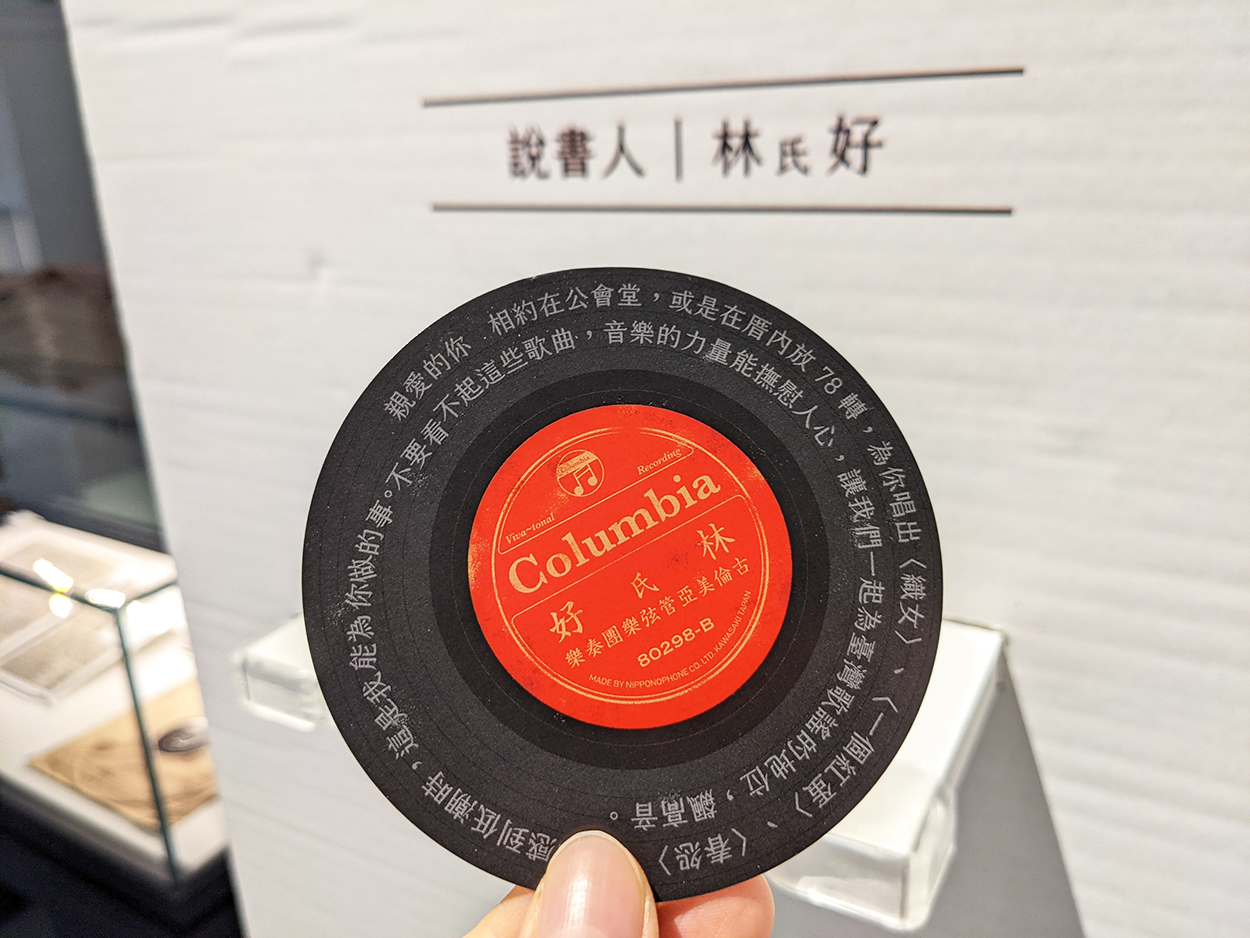
➹ Cultural Association Q&A
Q: Who were the four divas of the music industry in the 1930s?
A: During the heyday of the prewar Taiwanese pop scene, Chun Chun, coming from a Taiwanese opera troupe, once sang "Dancing eras" and "Rainy Night Flower." Ai Ai, whose real name was Jian Yue Er, was known for her song "Shine with Happiness." Lin Hau, whose style was different from that of Taiwanese opera, had the hit songs "One Red Egg" and "The Melancholy Under the Moon." These three singers brought Taiwanese songs into people's lives.
In 1935, an earthquake hit Hsinchu and Taichung. Musicians and singers joined in a concert tour across Taiwan to raise money for disaster relief. TAIWAN HSIN MIN PAO Chairperson Tsai Pei-huo initiated the "Concert for Disaster Relief," inviting Kao Chih-mei (a student of Toyo Music School) as the pianist. Other performers included Lin Qiu-jin, Gao Yue-na, Lin Cheng-mu, Li Jin-tu, Gao Jin-hua, and Chen Xin-zhen.
Singers and musicians who normally performed at public halls performed for local communities, writing a splendid chapter in Taiwanese music in the 1930s.
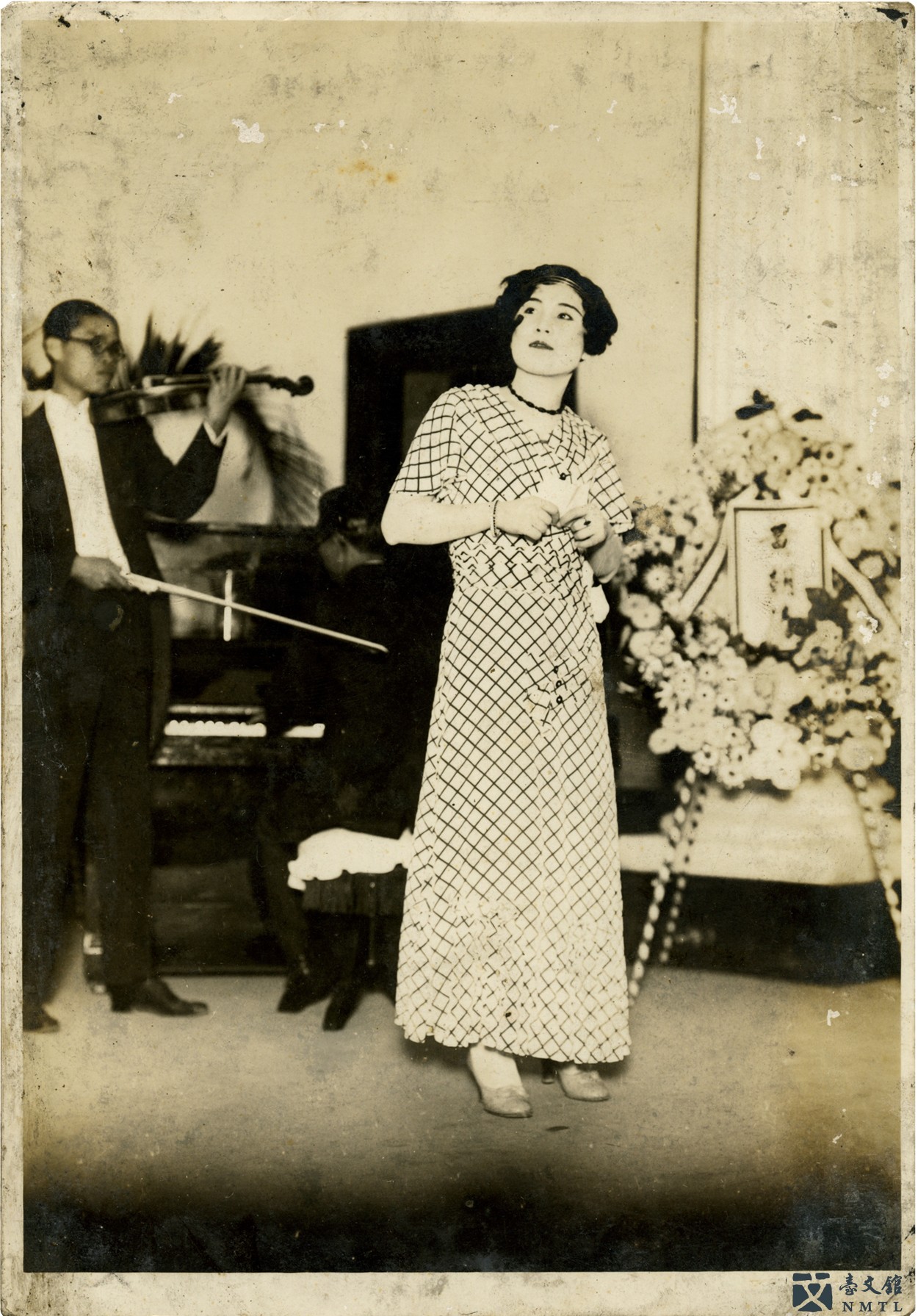
ღ Disaster Relief Photo: Photo of Lin Hau| In April, 1935, an earthquake struck Taichung, causing 3,000 deaths in Taichung and Hsinchu and 12,000 injuries. People from across Taiwan raised funds and collected disaster response resources. Meanwhile, Lin Hau used her singing skills to soothe the victims. This is a scene from her solo concert. The person playing the violin at the back is Zheng You-zhong.(Donated by Lin Zhang-feng)
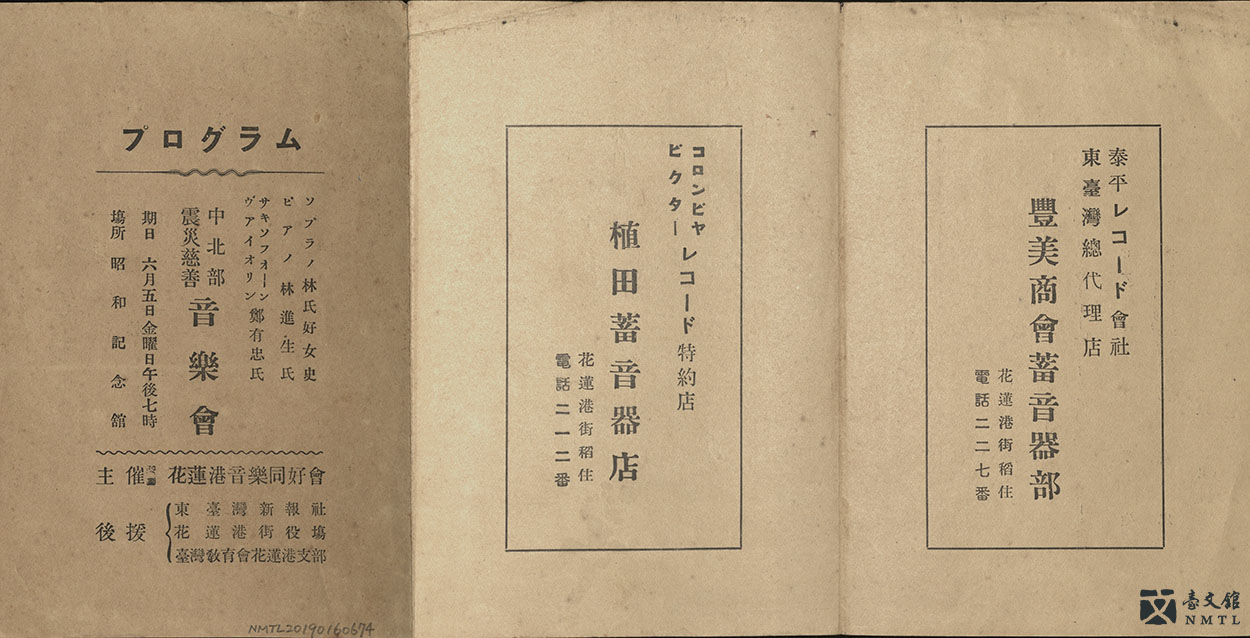
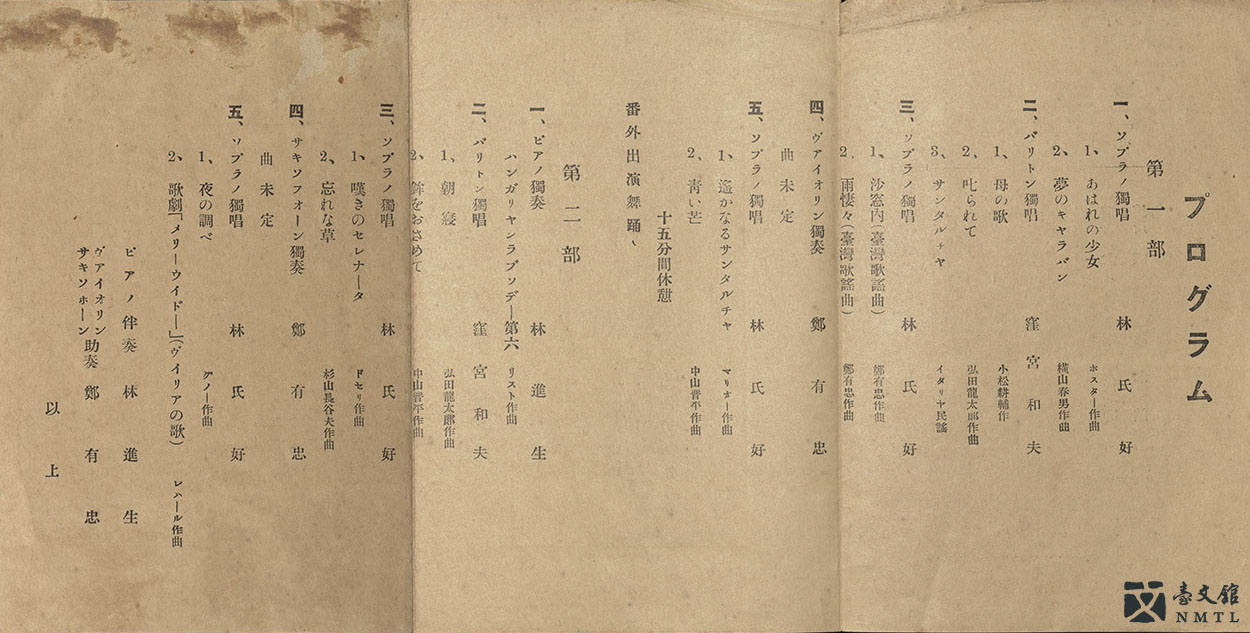
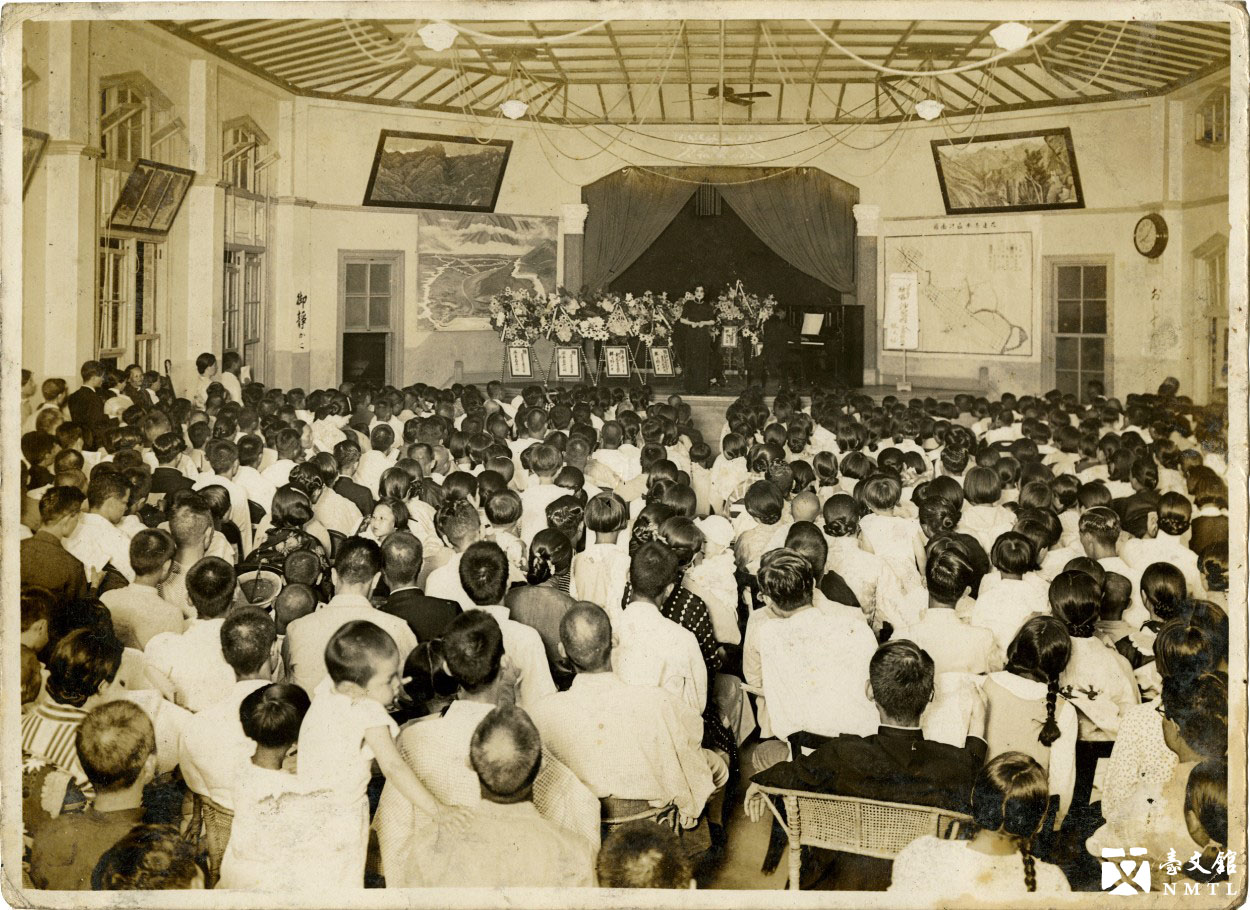
ღ Central and Northern Taiwan Disaster Relief Benefit Concert Flyer & Central and Northern Taiwan Disaster Relief Benefit Concert Photo| At 19:00, Friday, June 5th, 1935, the Hualien Music Association held a "Central and Northern Taiwan Disaster Relief Benefit Concert" at Hualien Showa Memorial Hall, inviting Lin Hau (soprano), Lin Jin-sheng (piano), and Zheng You-zhong (saxophone & violin). On that day, Lin Hau sang multiple songs, of which there were two Taiwanese songs written by Zheng You-zhong: "From the Inside of the Window" and "Melancholy Rain."(Donated by Lin Zhang-feng)

ღ Disaster Relief Music Concert Crew Photo in Caotun| On August 12th, 1935, the Disaster Relief Music Concert Crew had a group photo taken in Caotun. The tour of the "Disaster Relief Concert," initiated by Director of TAIWAN HSIN MIN PAO Tsai Pei-huo, was held from July 3rd to August 13th, 1935. The proceeds gained from the concerts were all used for disaster relief.
First row, from the left: Cai Shui-hui, Kao Chih-mei, Lin Qiu-jin, Tsai Pei-huo, Chen Xin-zhen, Lin Cheng-mu, and Gao Yue-na.(From the National Museum of Taiwan Literature permanent collection)
•. ♩ ♪♪ヾ(´〇`)ノ♪♪ ♫ ♩ .•
▍Phonograph Records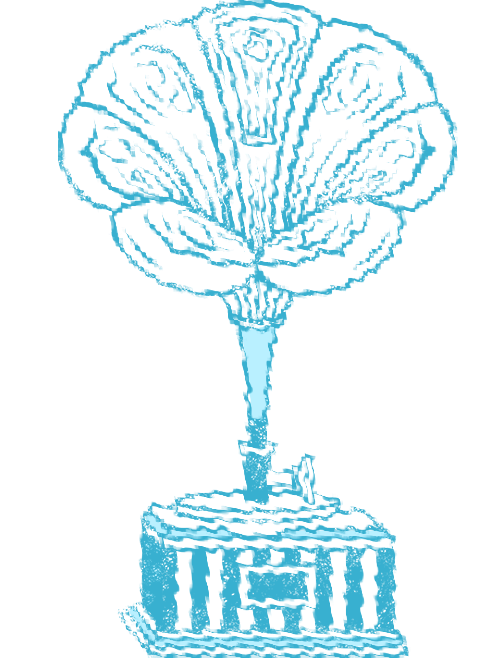
The shellacked records that were popular during the Japanese Colonial Period were made using a secretion of the kerria lacca insect from Southeast Asia. Rotating at 78 rpm, a single side was enough to fit three minutes of music. This type of record was introduced to Taiwan in the mid 1910s. At the time, recording studios did not exist in Taiwan. When a singer wanted to record, they had to travel to a studio in Japan by boat and the record would then be imported by a Taiwanese record company to be sold later. Many records from that era are still in existence. Here, three "Firsts" are displayed: "A Traveler's Song" made by Taiwan's first singer-songwriter Yao Zan-fu; the first public display of "Fun in the Fields" by lyricist Huang De-shi; and Taiwan's first hymn "Jesus is Your Best Friend."
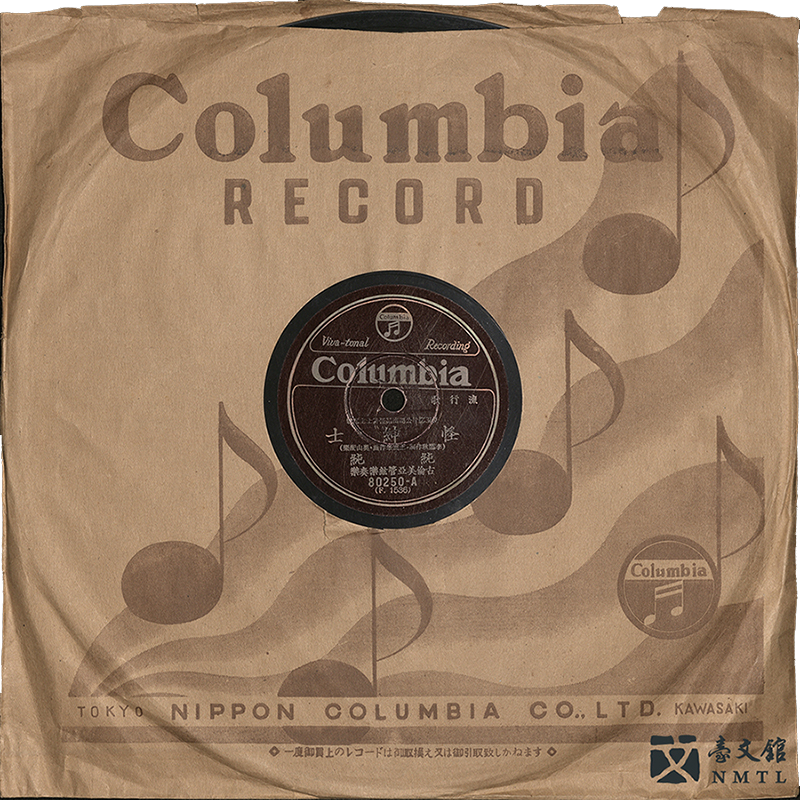
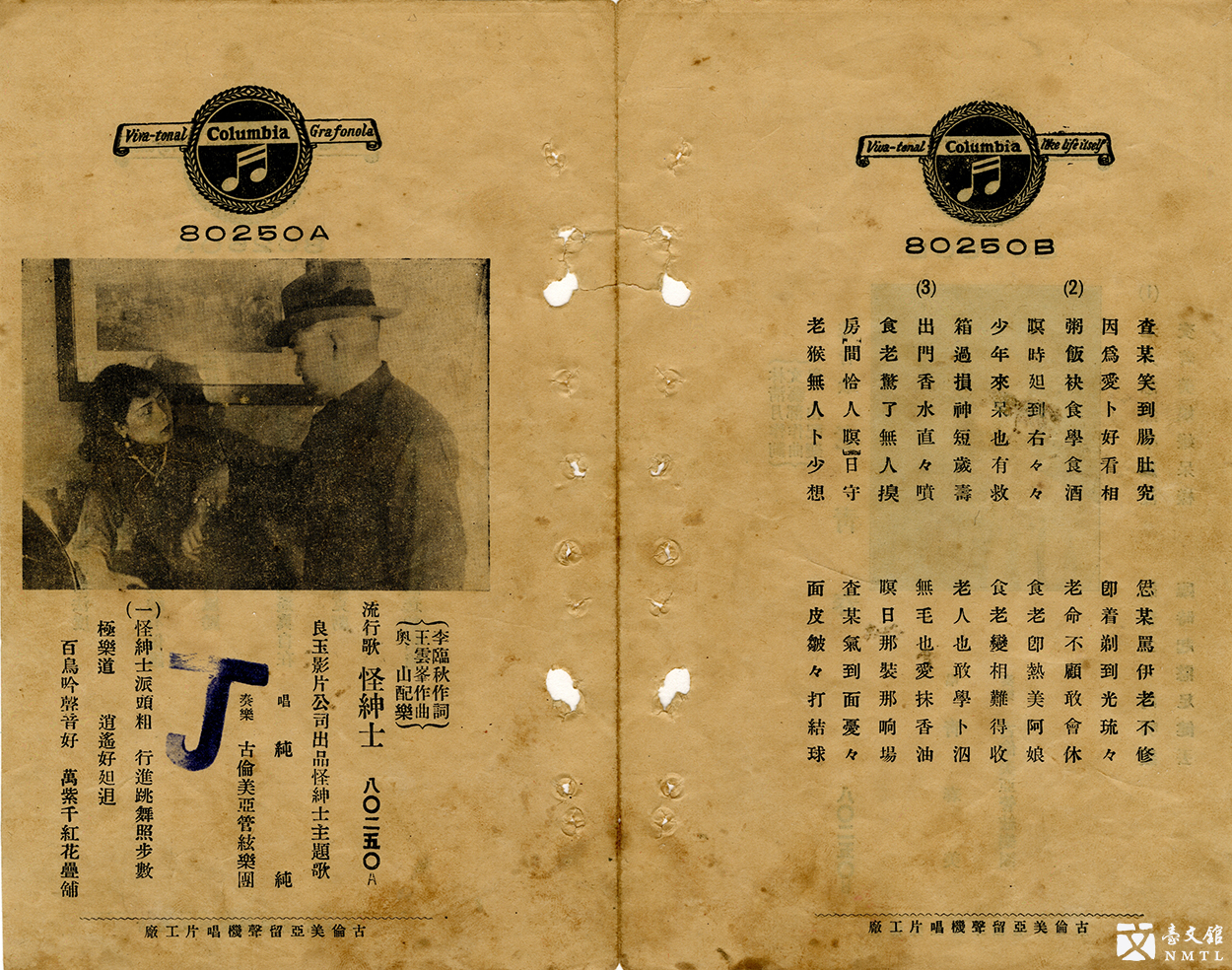
ღ "Strange Gentleman" Disc and Lyrics| THE PEACH GIRL was the first movie that was promoted with a theme song, which increased the sales of the record. In 1933, STRANGE GENTLEMAN, produced by Liangyu Film Company, also came with a theme song of the same name. Its lyrics were written by Lee Lin-chui and the music was composed by Ông Hûn-hong. The song was performed by Chun Chun and released by Columbia Records. Alongside the lyrics are stills from the STRANGE GENTLEMAN.(Provided by Song Record Culture Studio)
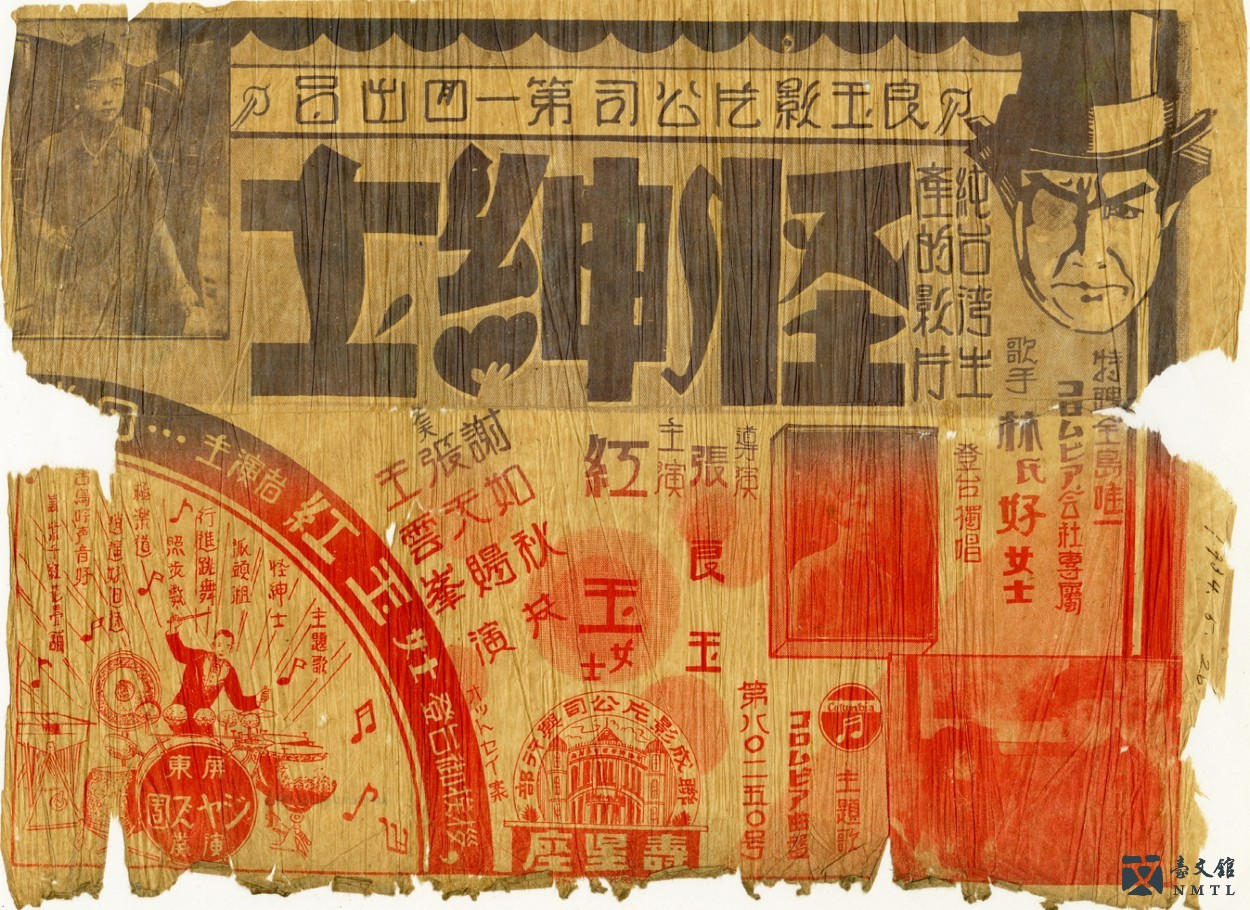
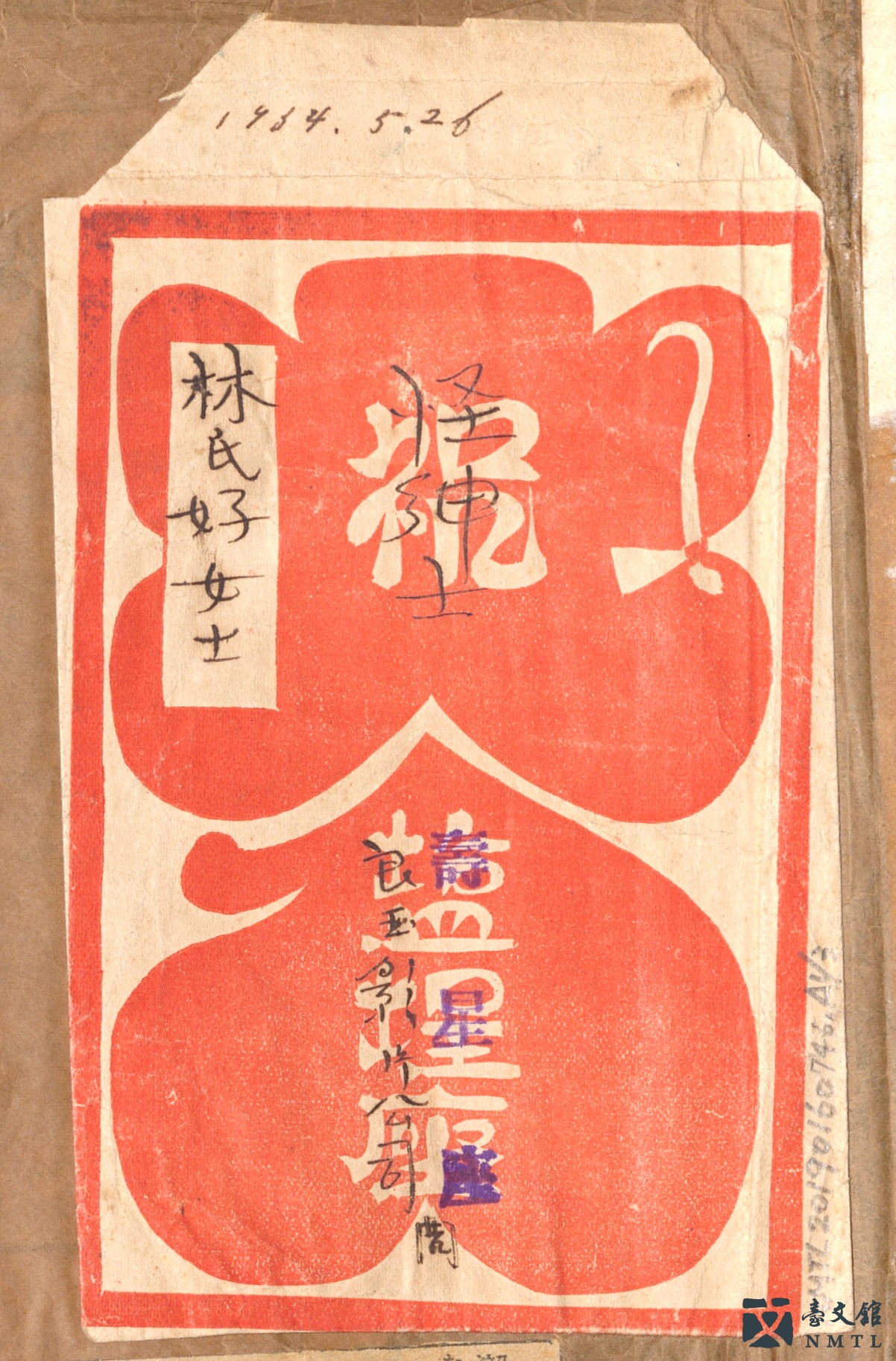
ღ Movie Poster: STRANGE GENTLEMAN—An All-Taiwan Production & Envelopes of STRANGE GENTLEMAN| In the 1930s, while a new film reel was being loaded, singers would go on stage to perform the theme song. In 1933, when STRANGE GENTLEMAN was shown in Kaohsiung, Lin Hau's name was printed on the poster as the performer of the theme song, although Chun Chun was the original singer. This was probably because Chun Chun and Lin Hau were both singers of Columbia Records and the cinema in Kaohsiung invited Lin Hau to perform the song.
The STRANGE GENTLEMAN envelope was probably a gift given by the cinema and Lianyu Film Company to Lin Hau.(Donated by Lin Zhang-feng)
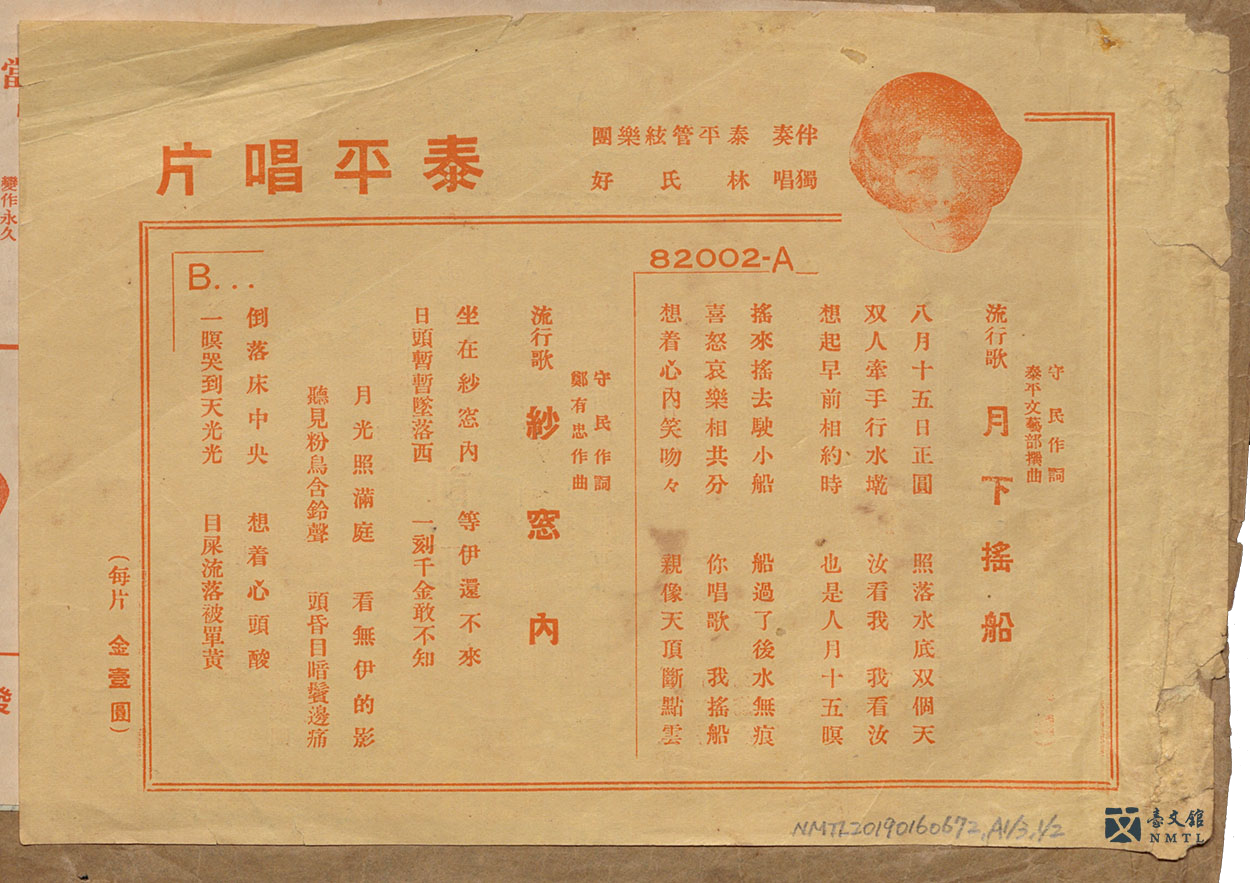
ღ Taiping Records: "Boat under The Moon" and "From The Window"| In 1934, the art and culture department of Taiping Records, led by Chen Yun-wang and Zhao Li-ma, produced and released a Taiwanese-language pop record numbered 82002. The songs were sung by Lin Hau and the musical part was played by Taiping Orchestra. The A side features "Boat Under The Moon", with its lyrics written by Shoumin (Lu Bing-ding). The B side features "From The Window", written by Zheng You-zhong (song) and Shoumin (lyrics). This record was a sort of duet performance by Lin Hau and her husband Lu Bing-ding.(Donated by Lin Zhang-feng)
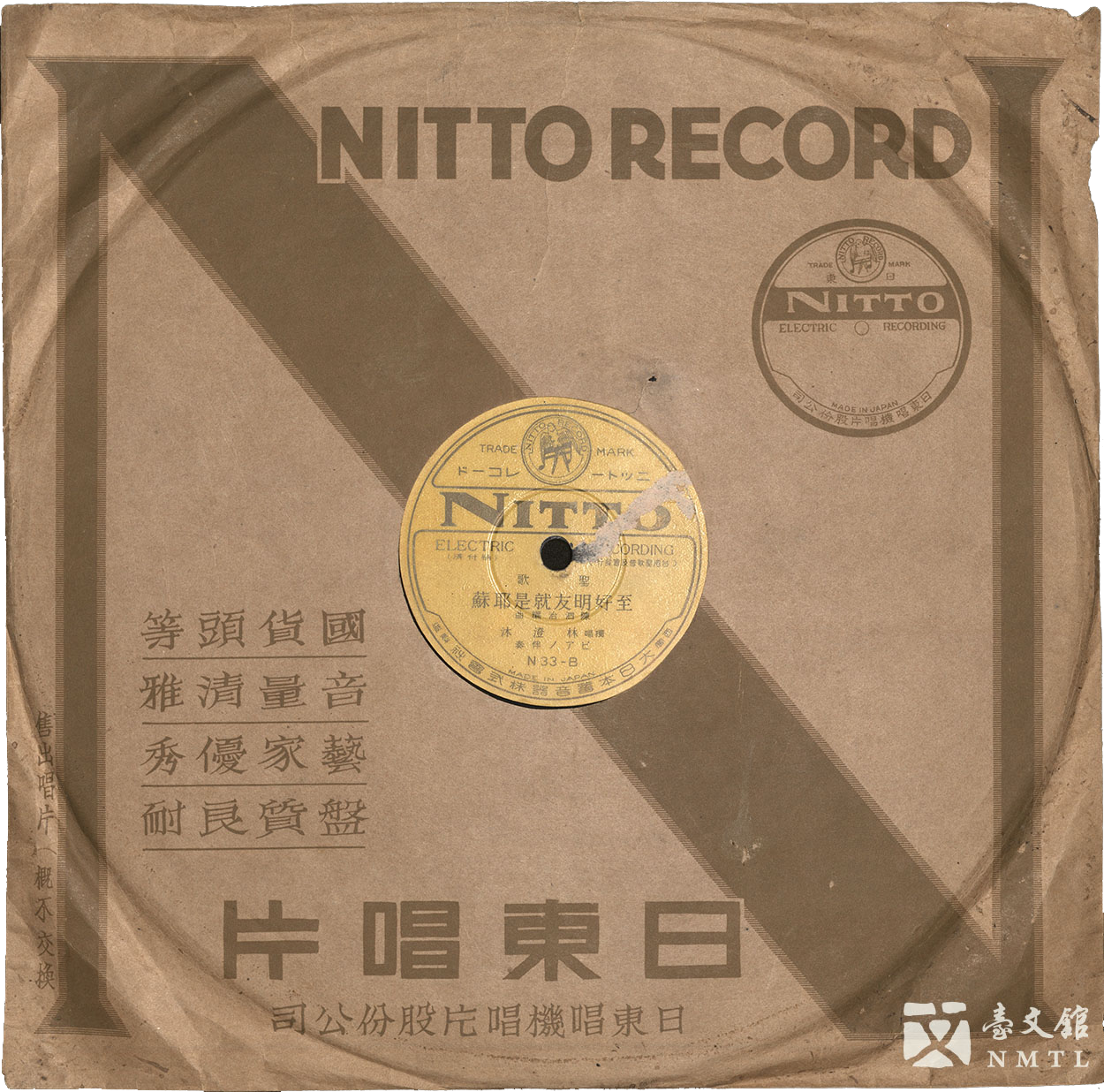
ღ "Jesus is Your Best Friend" Cover, Disc| This was produced by Nitto Records and released by the Taiwan Hymn Association. The composer, Chen Si-zhi, wrote the song based on Taiwanese hymn No. 275. It was performed by Lin Cheng-mu, a doctor and musician from Tainan, adding a hymn song to the list of records released during the Japanese Colonial Period.
Chen Si-zhi and Lin Cheng-mu were both Christians. This song was not their first collaboration. They had already joined Yang Zhao-jia's "Taiwanese in Tokyo Association" and the "Local Concert Tour" held by TAIWAN HSIN MIN PAO. They also participated in the Disaster Relief Music Concert held by Tsai Pei-huo in 1935.(Provided by Song Record Culture Studio)
•. ♩ ♪♪ヾ(´〇`)ノ♪♪ ♫ ♩ .•
▍Humorous Crosstalks
Are folktales a branch of literature? This was a question discussed by intellectuals in the 1930s. Folk literature were collected in local communities and included folktales, legends, songs, humorous stories, and idioms. In the 1930s, record companies primarily made records in two mainstream entertainment genres: popular songs and Taiwanese opera. There were also humorous crosstalks, which involved two people talking in turn. The conversations were rhythmic and the values and topics differed from those of intellectual discussions. They were the most authentic banter and criticisms about social issues among common people. In the midst of teasing remarks, these crosstalks reflected a sense of compassion for society. The earliest surviving humorous crosstalks "Prostitutes and Thugs" and "Trendy Young People" were recorded on the same disc.
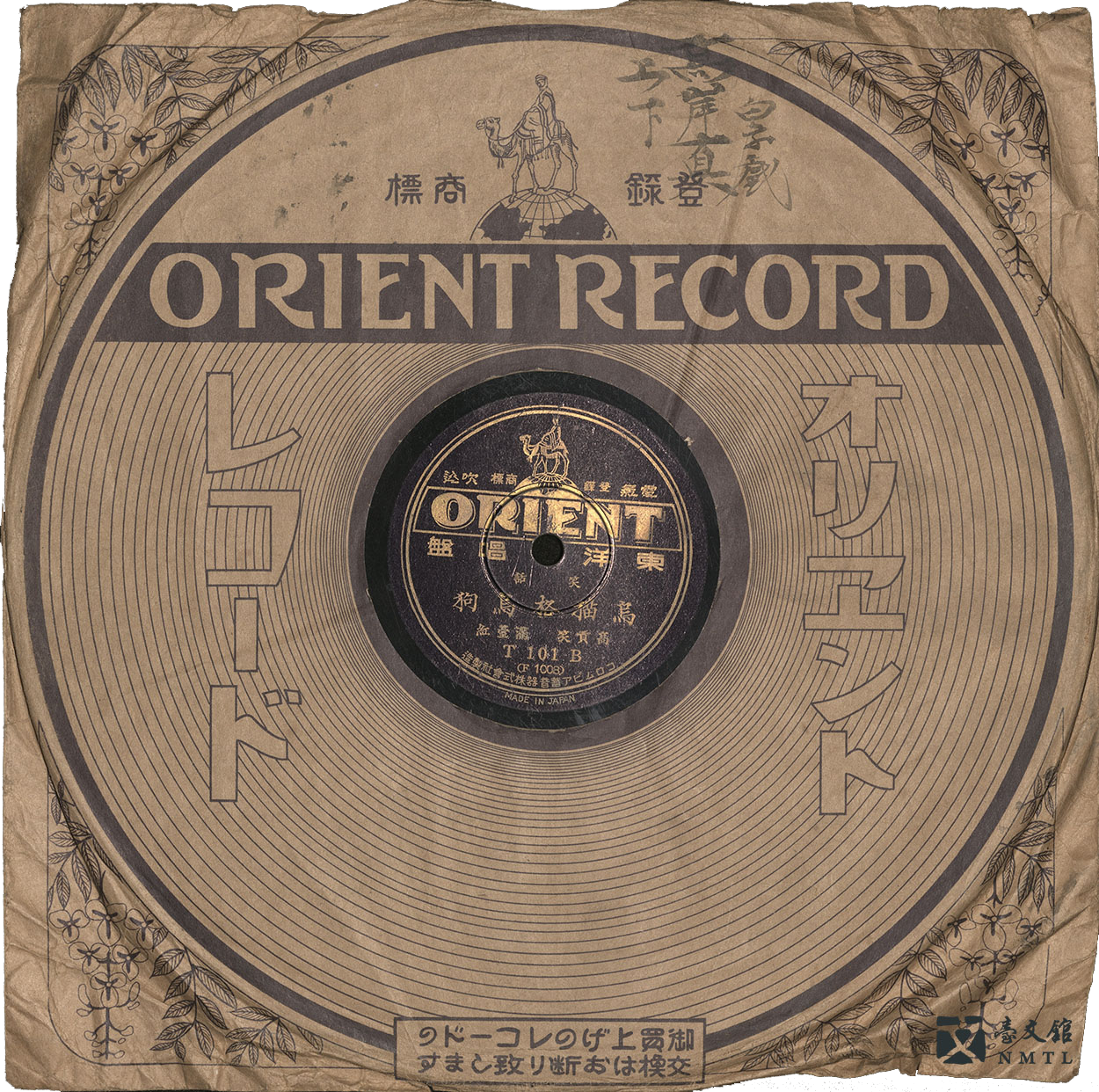
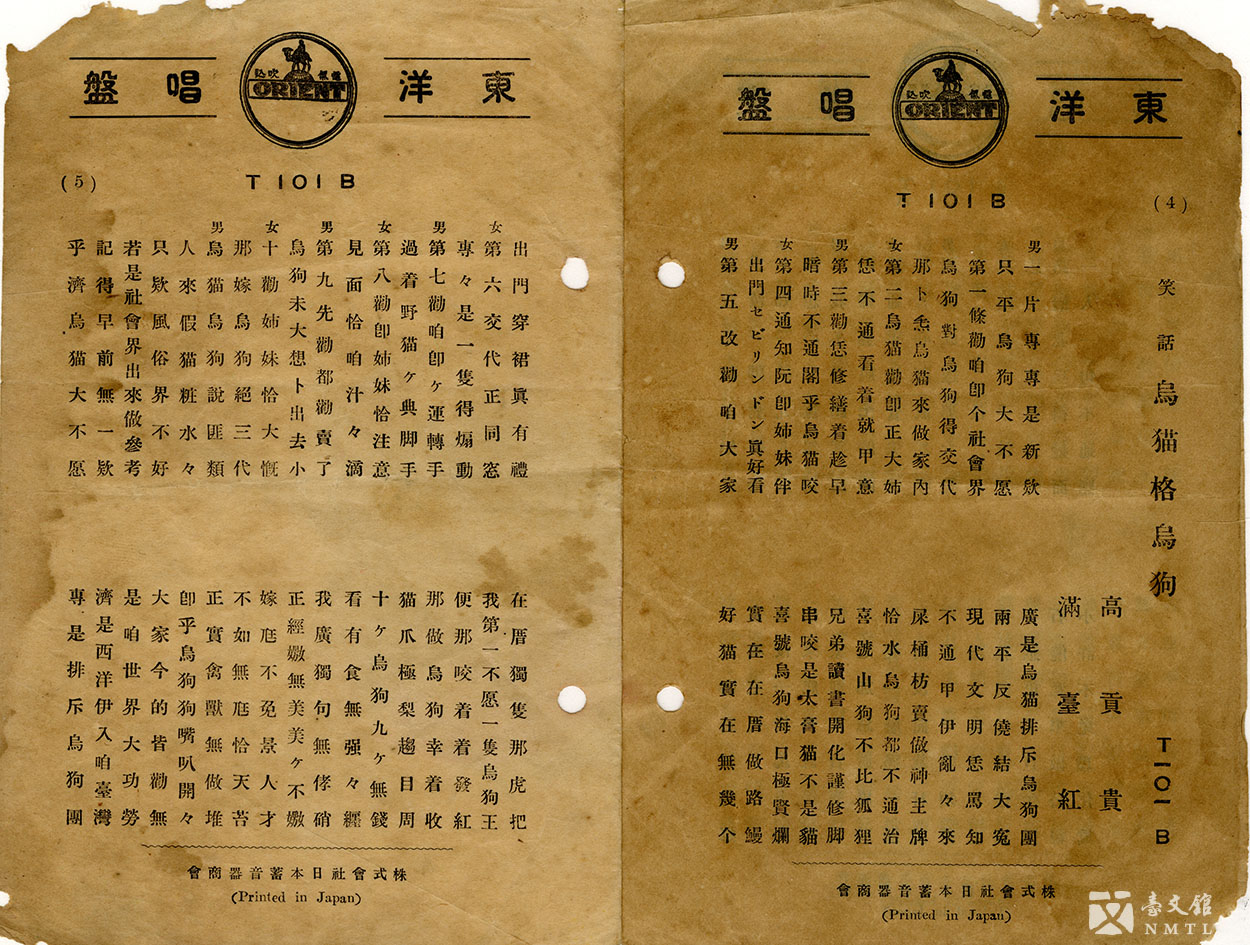
ღ "Trendy Young People" Cover, Disc, and Lyrics| This album was released by Dongyang Records and numbered T101B and T101A. The disc was printed with the camel trademark of Dongyang Records. It was the earliest record of humorous crosstalks. Each side includes one crosstalk piece: "Trendy Young People" and "Prostitutes and Thugs." One of the performers on "Trendy Young People" was Chun Chun.(Provided by Song Record Culture Studio)
•. ♩ ♪♪ヾ(´〇`)ノ♪♪ ♫ ♩ .•
▍Children's Songs
On January 1st, 1931, Huang Zhou's article "One Suggestion for Compiling Children's Songs " was published in TAIWAN SHIN MIN PAO. He was worried when he heard children on the street singing only Japanese children's songs. For him, Taiwanese children's songs were also very interesting. Therefore, he drafted this treatise on the meaning of preserving Taiwanese children's songs and invited people to submit children's songs, folktales, legends, and related folk customs.
At the end of his call for submissions, he particularly highlighted that "the authenticity of songs and folklore is of the utmost importance, and thus they should not be polished and the colloquial wording should not be changed to standard or classical Chinese." Indeed, there was no distinction between refined and colloquial in Taiwanese literature. All songs touched people's hearts and were extremely catchy. Today, we can still sing these songs: let's go fly a kite/there are many people in the field/some are standing and some are sitting/lets go fly a kite.
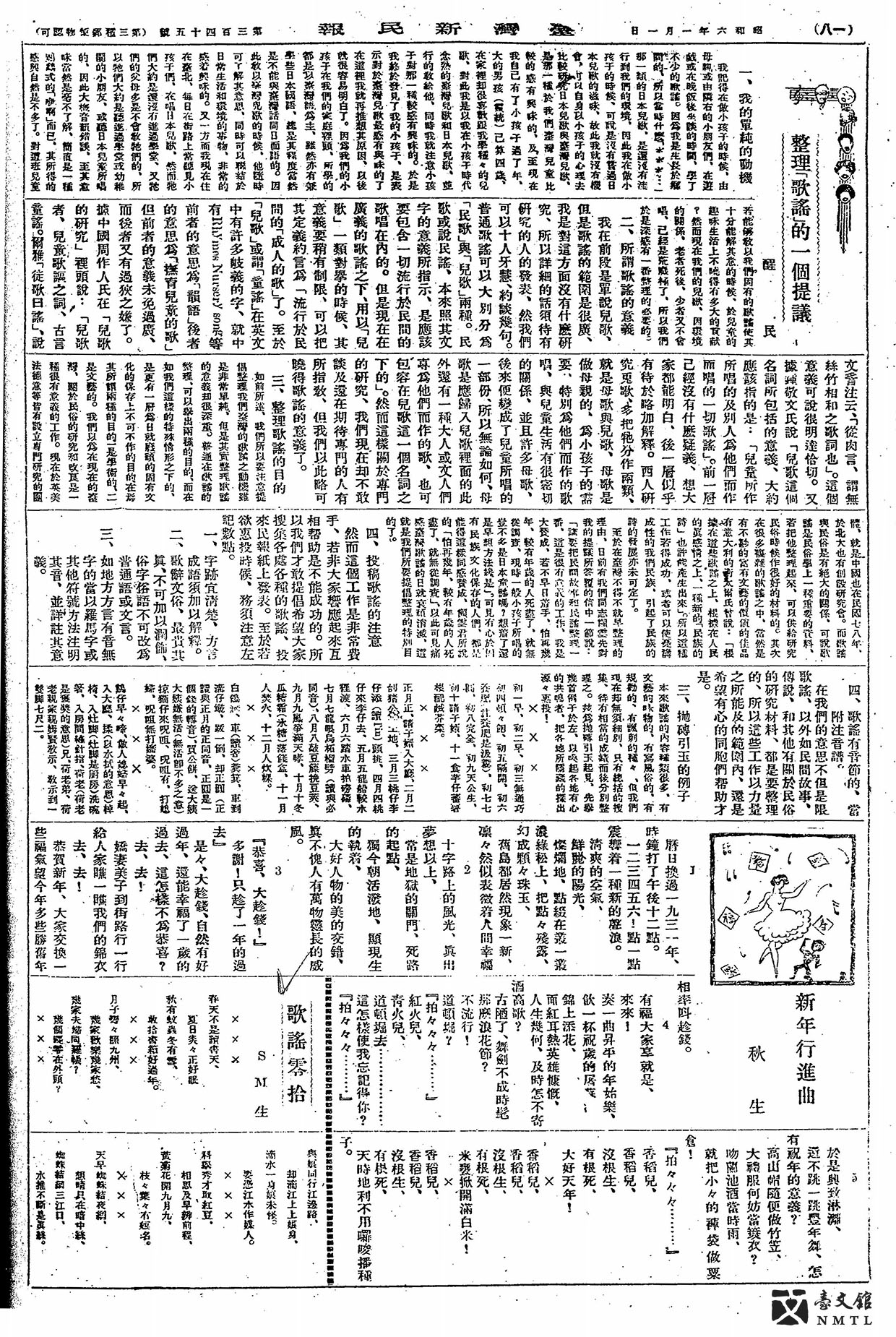
ღ Xingmin (Huang Zhou) "One Suggestion for Compiling Folk Songs" TAIWAN HSIN MIN PAO| On January 1st, 1931, Huang Zhou published "One Suggestion for Compiling Folk Songs". He cautiously stated the meaning of compiling folk songs in terms of culture preservation and invited people to submit songs. The day was also New Year's Day in Japan, so at the end of the article, the author mentions the lyrics of a New Year Song in Taiwan: "Get up early on the first and second day of New Year; sleep late on the third day; eat to your heart's content on the fourth day......."(Collection of the National Museum of Taiwan Literature)
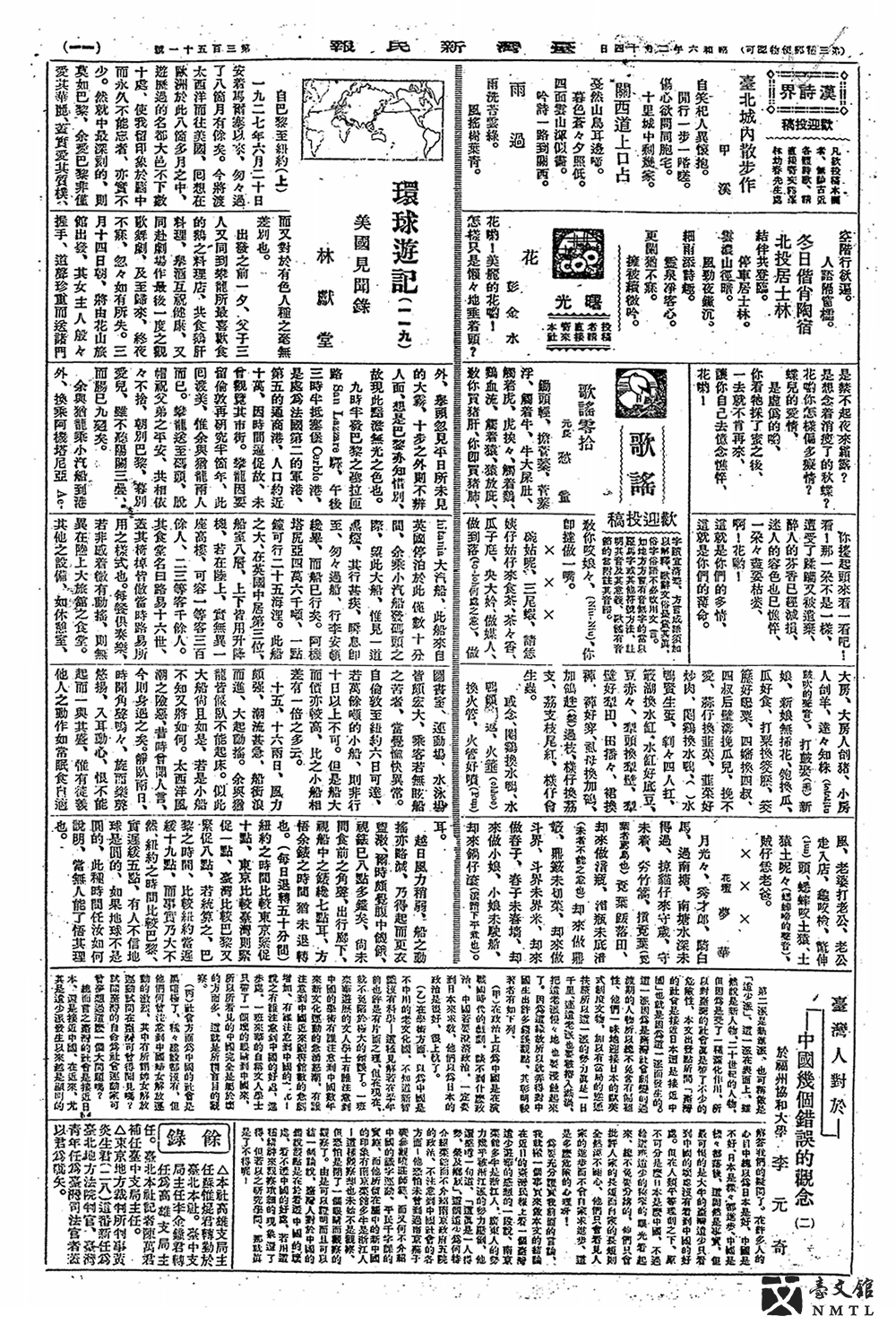
ღ TAIWAN HSIN MIN PAO Call for Submissions| After Huang Zhou called for submissions on New Year's Day in 1931 in his "One Suggestion for Compiling Folk Songs," a column dedicated to "folk songs" was added to TAIWAN HSIN MIN PAO. On February 14th, 1931, Cai Qiutong from Yuanchang submitted a variety of songs involving all sorts of farm elements: chickens, sheep, ducks, mangos, lychees, and crickets. Meng Hua from Huatan submitted a song that goes like this: "Under the moonlight, the scholar rides a white horse, passing through Nantang but in vain because Nantang's water is deep. Welcome the new year with the cat." This children's song can still be heard today.(Collection of the National Museum of Taiwan Literature)
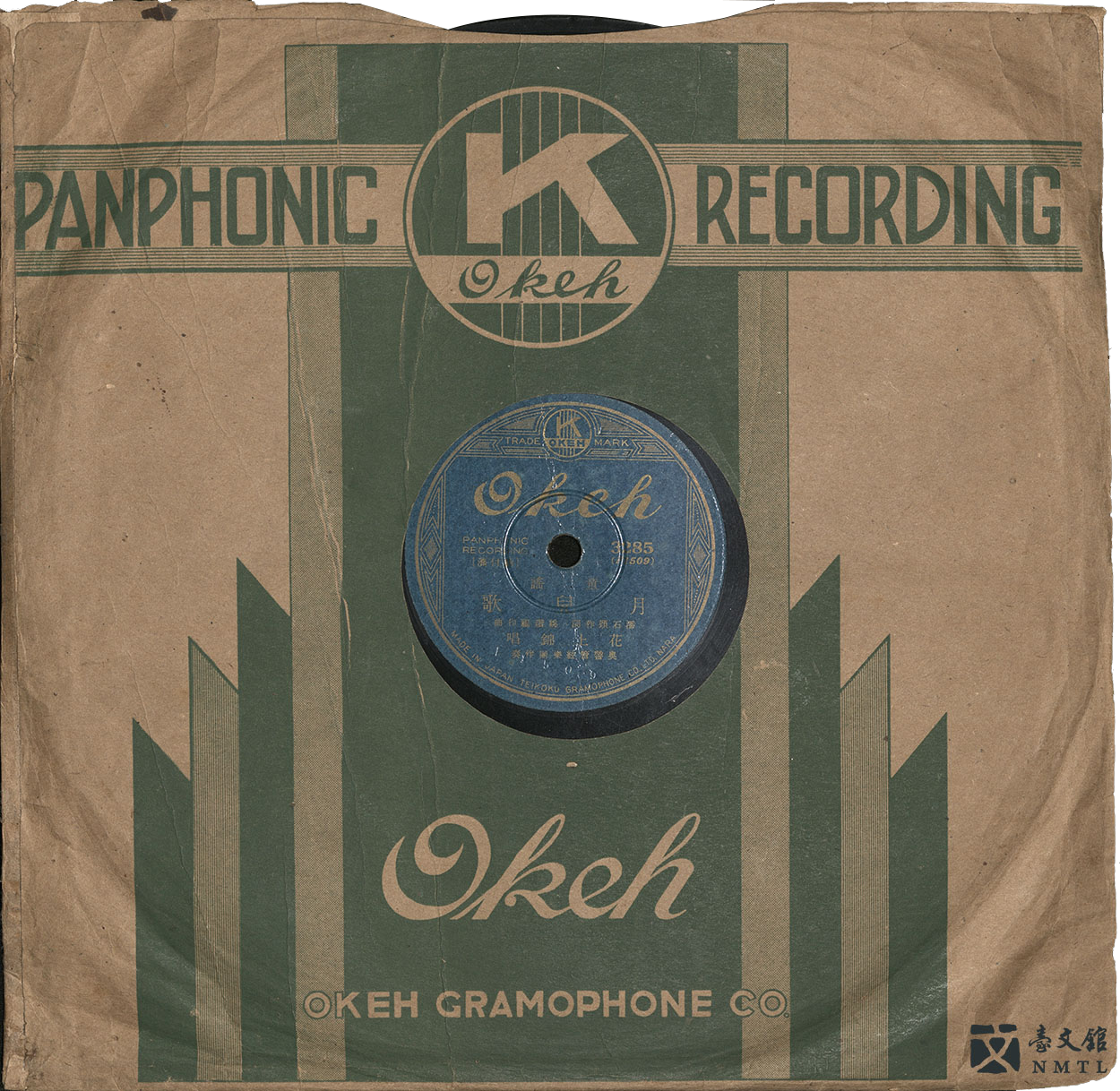
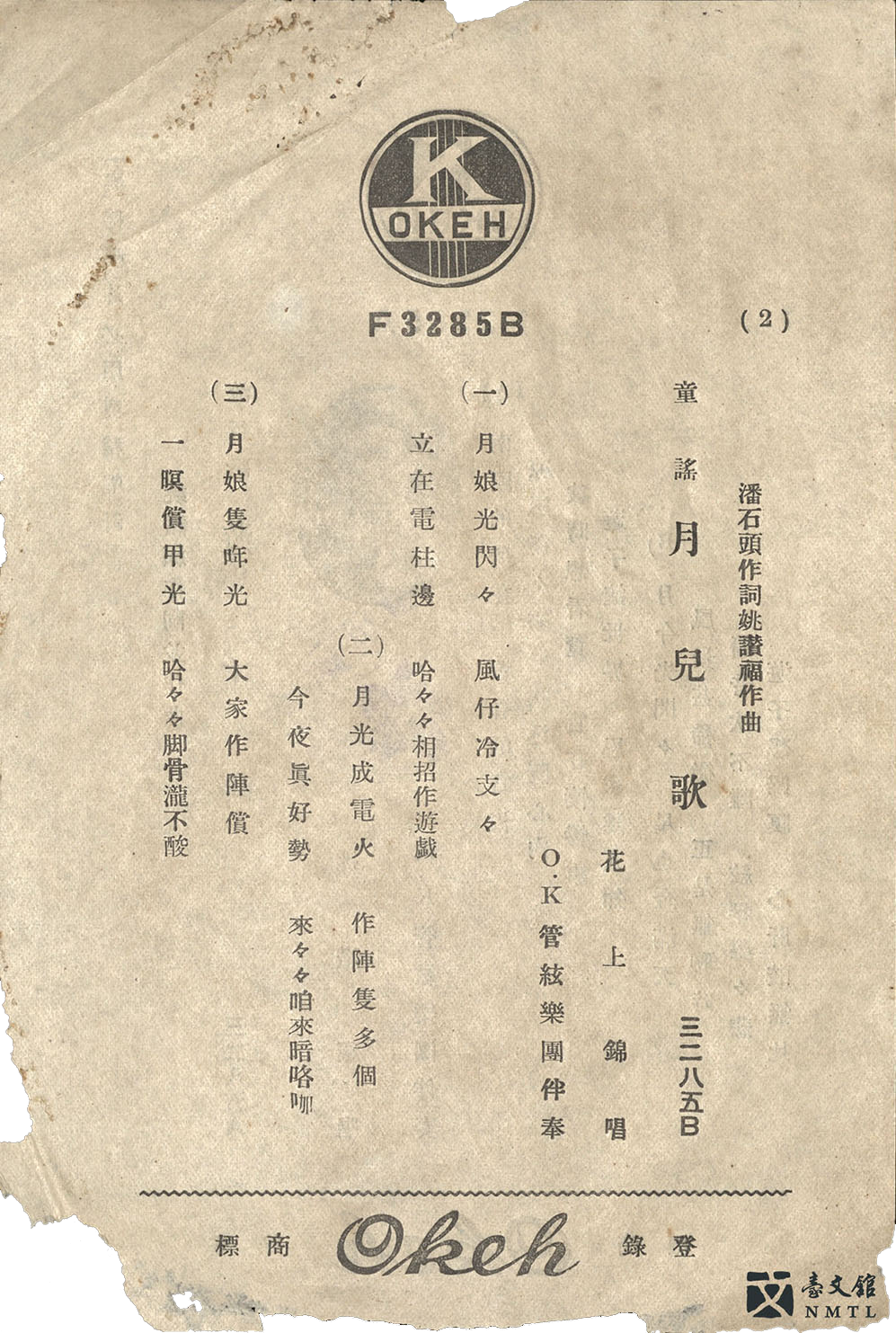
ღ "Moon Song" Cover, Disc, and Lyrics| Around 1935, a children's song called "Moon Song" was released by Okeh Records. The lyrics were written by Pan Shi-tou and the music was composed by Yao Zan-fu. The line "Standing next to the utility pole" suggests that there were already street lights in Taiwan, and "hide and seek" tells that this game was played by children at the time.
The other side of the disc is "Homesick Chant," the lyrics and music of which were written by Yao Zan-fu. The song was also performed by him. Yao was once a pastor. His father did not support his music career and kicked him out. Yao wrote this song at the time. With the discovery of this disc, people can listen to Yao's voice for the first time.(Provided by Song Record Culture Studio)
•. ♩ ♪♪ヾ(´〇`)ノ♪♪ ♫ ♩ .•
▍Pop Songs
In 1929, the Japanese Gramophone Chamber of Commerce published "Black Cat," which was the first known record disc printed with the words "pop music." In 1932, the movie PEACH BLOSSOM WEEPS TEARS OF BLOOD was introduced to Taiwan. The song of the same name became a surprise hit. Columbia Records became the first major record company because of making this record. In 1933, Columbia Records released several pop songs, including "Spring Wind," "Sound of A Red Warbler," "Dancing Era," and "Sigh of Flowers," turning them into iconic Taiwanese songs.
The art department of Taiping Records was run by Chen Yun-wang and Zhao Lima, who also began to record Taiwanese pop songs. Among these, "Formosa Island," with lyrics by Huang De-shi and music by Zhu Huo-sheng, reflected a mature awareness of Taiwanese identity. In 1935, Shengli Records was founded, with Zhang Fu-xing hired to run its art department. In 1936, Yao Zan-fu adapted a Taiwanese opera song for a "new style of intentional vocal breaks"— "Sorrow." Chen Chun-yu described this unprecedented phenomenon as "When the song plays, the sadness spreads far; everywhere is filled with great sorrow."
Exactly what kind of songs are the songs we need in daily life? In my opinion, we should honestly make songs for the common Taiwanese people and make rules for these songs so that people will know what the songs are about. The melody should reflect the uniqueness of Taiwan and be easy to learn so that people can sing them for comfort whenever they want. These are the songs of the people.
—Chen Chun-yu, "The Future of Taiwanese Songs," STARTING TROOPS

ღ "Beautiful Island" Cover, Disc| In 1935, "Beautiful Island" was produced by Taiping Records. At the center of the cover is an indigenous girl wearing high heels and playing a traditional string instrument. It was an innovative design during the Japanese Colonial Period.(Provided by Song Record Culture Studio)
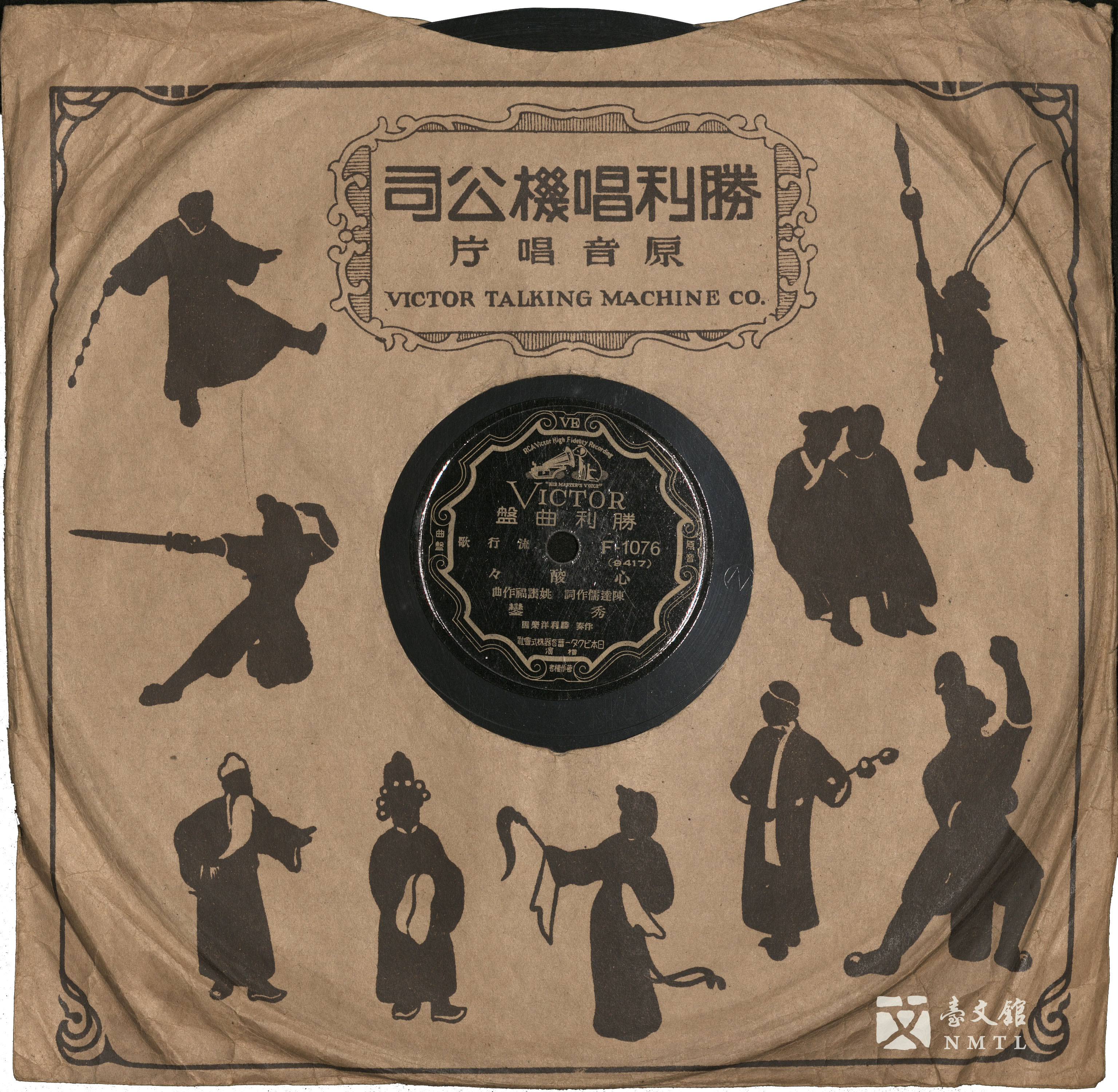
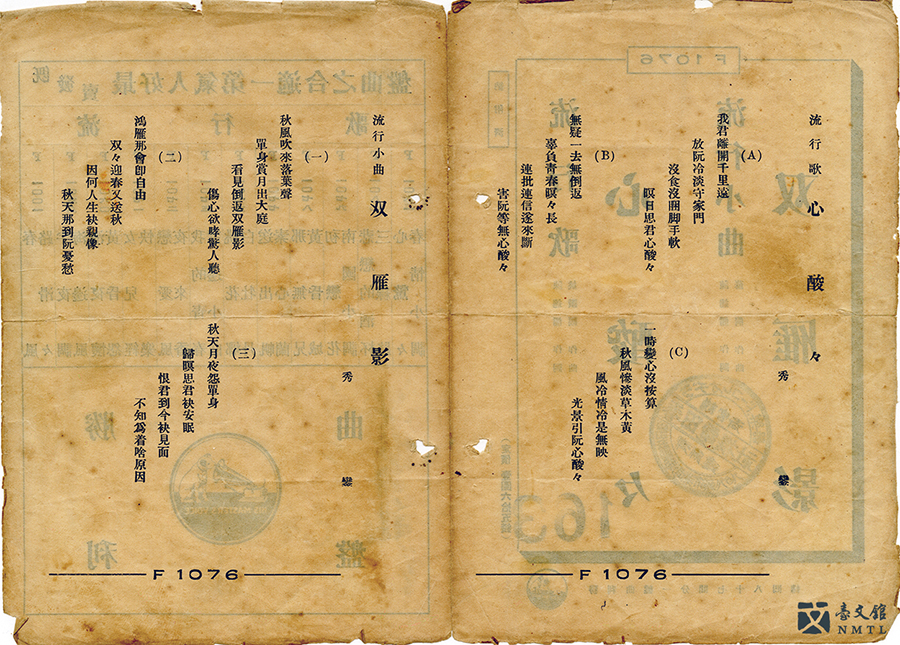
ღ "Heart of Sorrow" Cover, Disc, Lyrics| "Heart of Sorrow" was produced by Shengli Records and numbered F1076 in 1936. It was the bestselling disc during the Japanese Colonial Period. The lyrics were written by Chen Ta-ju. He was an important lyricist of the company and wrote many lyrics about romantic relationships. Composer Yao Zan-fu had training in Western music and gleaned inspiration from the crying tone of Taiwanese opera, making music using a touching "new-style crying tone." On the back of the lyrics, one can see the other pop songs made by Shengli Records around the same time.(Provided by Song Record Culture Studio)
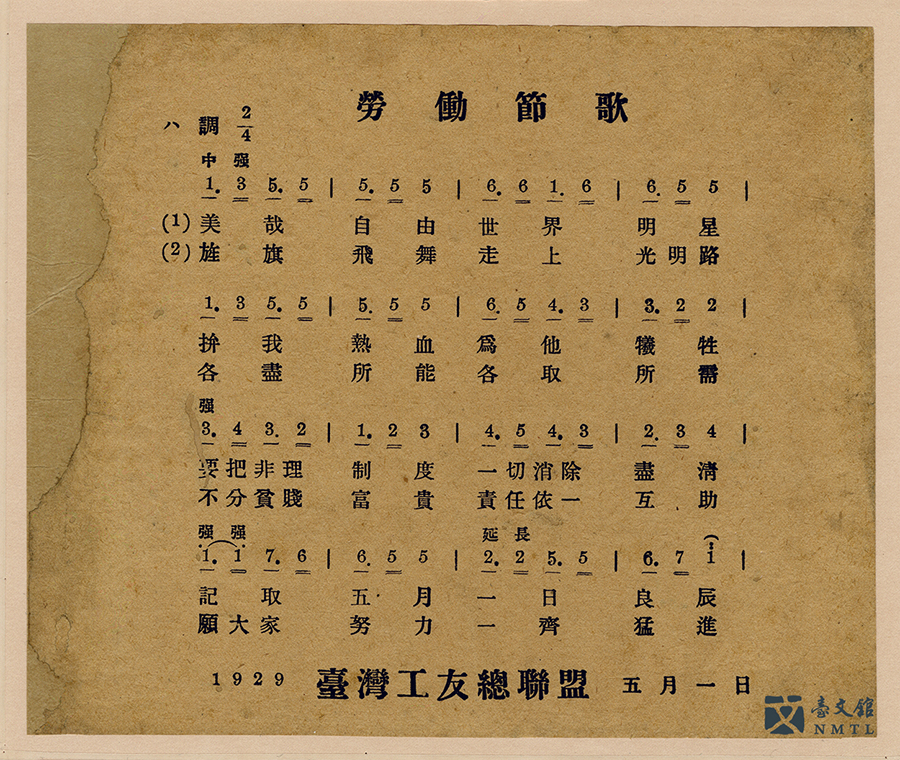
ღ "Labor Day Song"| On May 1st, 1929, a song about Labor Day that was allegedly written by Chiang Wei-shui, the founder of the Taiwanese Labor Union, was released. The song goes like this: "Let's do our best and take what we need; We must help one another regardless of social status." The song was a plea for collaboration among workers and the equal distribution of social resources. This way of thinking apparently came from socialism. With burgeoning left-wing movements at the time, the nationalistic traits of Taiwanese Labor Unions also changed.(Provided by Zhuang Ming-zheng)
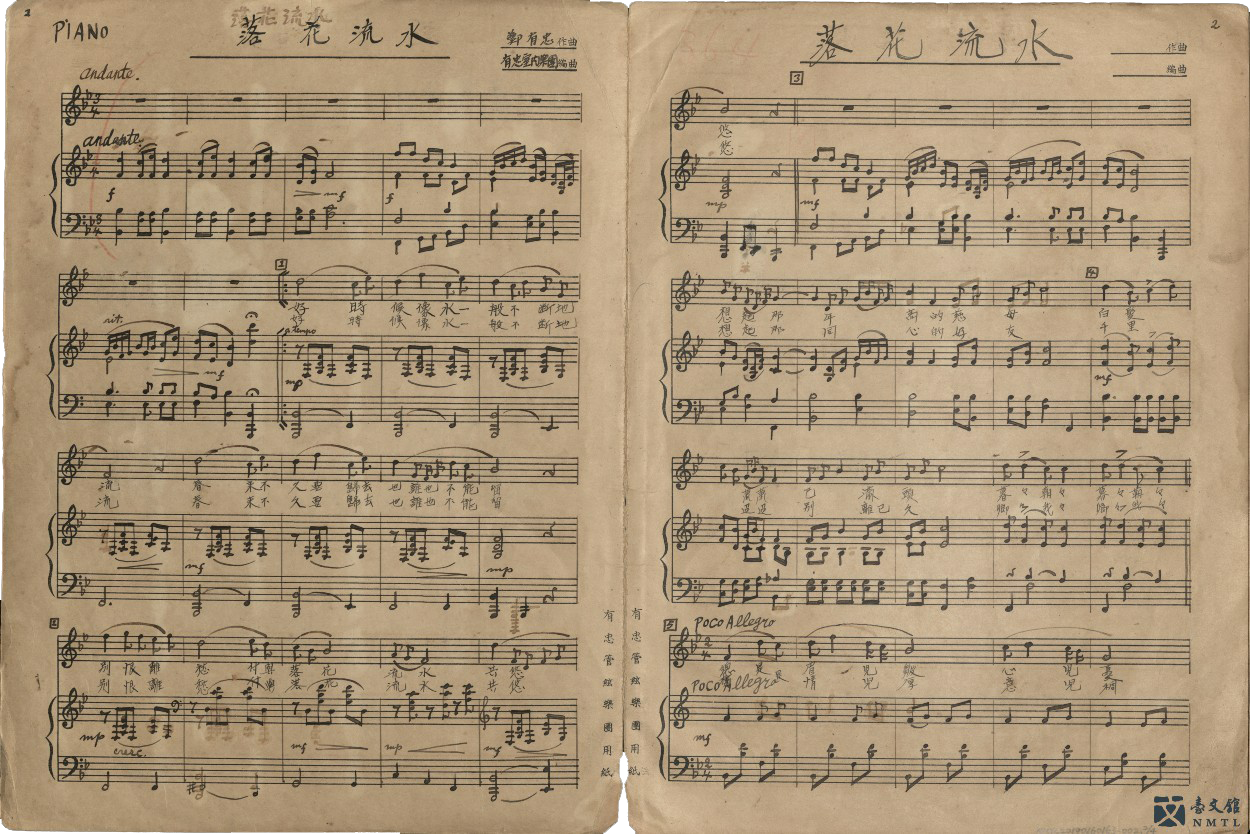
ღ Music Score of "Falling Flowers and Flowing Water"| There are now two versions of Falling Flowers and Flowing Water written by two different lyricists and composers. The first version was written by Zheng You-zhong with lyrics by Lu Bin-ding. The second version was written by Li Jin-hui (both music and lyrics). The first version is about an outlander expressing how he misses his senile mother as he is unable to return home. The second version is an apology and expression of affection toward a lover who has been waiting for long.
Lyrics of "Falling Flowers and Flowing Water" (1st version): "For a while, time flows continuously like water; spring is almost gone despite its short stay and nobody can stop it from happening; the sorrows of parting; the passing of time is like falling flowers and flowing water; I think of my senile mother, whose hair is now completely white." The song is filled with melancholy.(Donated by Lin Zhang-feng)
•. ♩ ♪♪ヾ(´〇`)ノ♪♪ ♫ ♩ .•
▍Taiwanese Opera
In the 1920s, Taiwanese opera became extremely popular. From the street to the theater, Taiwanese opera had evolved into full-scale performances. It also changed to reflect more melancholic and chivalrous themes. However, before it became full-scale, the slightly erotic "Butterfly Lovers" and "Chen San Wu Niang" were already popular among common people and developed into unique Taiwanese opera genres in different regions, including Hengchun Folk Songs, Tainan Folk Songs, Seven-Word Songs, and Crying Tone. In the 1930s, Taiwanese opera was controversial. Intellectuals considered it depraved. The Taiwanese People's Party founded by Chiang Wei-shui criticized Taiwanese opera in its party platform. Yet, this did not affect its popularity. Record companies, sensing the commercial potential, gladly made and sold Taiwanese opera recordings.
➹ Cultural Association Q&A
Q: What are Koa-á books?
A: There was a performance art that was popular in Southeast China and Taiwan during the Qing Dynasty known as "Koa-á;" Koa-á books were the texts for this art. Koa-á was the entertainment of the people. It touched on a variety of themes, including the "Song of Advice," which tells people to do good, THE LATEST VERSION OF THE CANAL INCIDENT, which was adapted from an actual contemporary event, and KEELUNG ROOM NO. 7 TRAGEDY, SONGS OF BUTTERFLY LOVERS, and other narratives. Koa-á songs contain seven-word lines interspersed with lines of other lengths. Taiwanese and Hakka are the two major languages used. As both these languages are tonal, words written in these languages sound musical when read. Koa-á books can be seen as historical records that reflect contemporary folk culture.

✒ Fixated on the Limelight. Performance Theater in Pre- and Postwar Cultural Movements
In the early days of the Taiwanese Cultural Association, a resolution was made: "host photo exhibitions, concerts, and plays to correct improper habits and promote the development of tasteful hobbies." This was a new era for the Taiwanese drama scene. Different from traditional dramas such as Taiwanese opera, new dramas were more "enlightened". In the 1920s, there was the Starlight Theatrical Troupe and Anping Theater Association. In the 1930s, Zhang Wei-xian, Ming Feng Theatre, Lin Tuan-chiu, and Housheng Theatre Society all laid the foundation for Taiwan's modern theatre and connected with the needs of social movements.
In the 1940s, the process of Nipponization in Taiwan began. Writers promoting nativist literature such as Huang De-shi adapted traditional dramas like Taiwanese opera and glove puppetry with elements of Japanese sword fighting and historical novels, hoping to preserve these traditional dramas. During the war, although these cultural movements seemed to disappear from Taiwan altogether, they continued to exist in local and folk art forms.
At the beginning of the postwar period, Jian Guo-xian and Song Fei-wo established the Shengfeng Theatre Society. In 1946, they performed the one-act play—WALL, which reflected the extreme wealth gap in Taiwanese society after the war. Gaining enormous traction, the play was forced to be canceled by the police for instigating class conflict, meaning the disbandment of the theatre troupe. Yet, the cultural movement initiated by the theatre sector continued offstage.
____.¸¸.¤·.¸¸.·´¯`·.¸¸.¤ ღ ¤·.¸¸.·´¯`·.¸¸.¤·.¸¸.____
Dear,
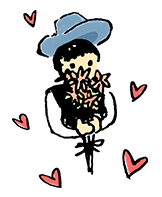 Under the red soil of the Dadu Plateau is the fragrant land. We bend over to put our roots in the soil. As long as our goals for the people are the same, even if the people of my generation cannot achieve them, there will always be the next generation. With persistence, generation after generation, I will be in the garden, waiting for you to come.
Under the red soil of the Dadu Plateau is the fragrant land. We bend over to put our roots in the soil. As long as our goals for the people are the same, even if the people of my generation cannot achieve them, there will always be the next generation. With persistence, generation after generation, I will be in the garden, waiting for you to come.
Reference: Yang Kui, "The Foolish Old Man Removes The Mountains."
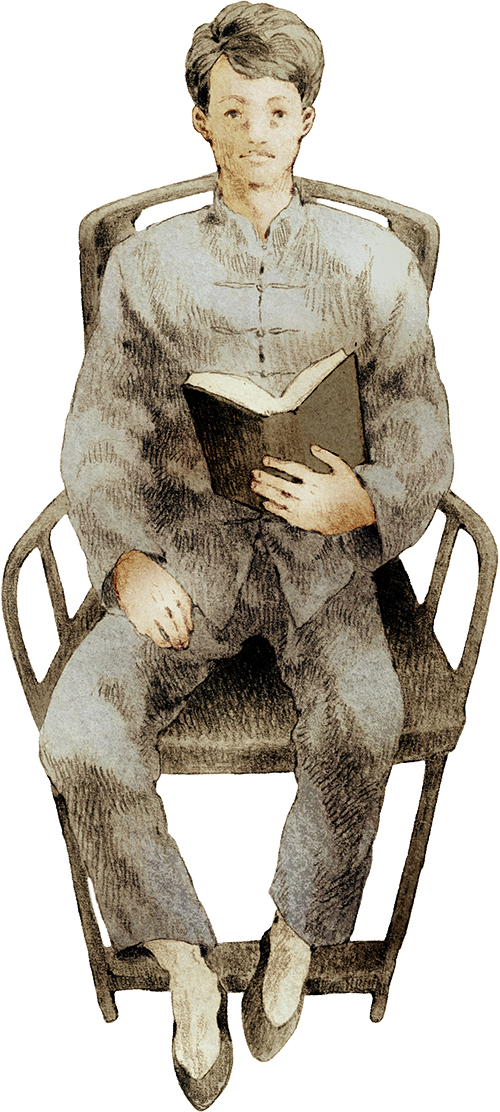
📪️ Yang Kui (1906-1985), born in Xinhua, Tainan. His real name was Yang Gui. He graduated from Tainan Second Middle School (now National Tainan First Senior High School) and the night school of the Literature and Arts Department at Nihon University.
In 1927, he joined the Taiwan Farmers Coalition and Taiwan Cultural Association. In 1934, he won second prize for his work "Paper Delivery Person." In 1935, he founded the TAIWAN NEW LITERATURE magazine. His works are mostly novels, but he also authored theatrical scripts and critiques. His works reflect attention toward the interests of the general public. After the war, he was arrested for drafting the "Peace Manifesto" and was jailed for 12 years on Green Island. His works include "You Cannot Lock Up Spring" (later on renamed as "Uncrushable Roses.")
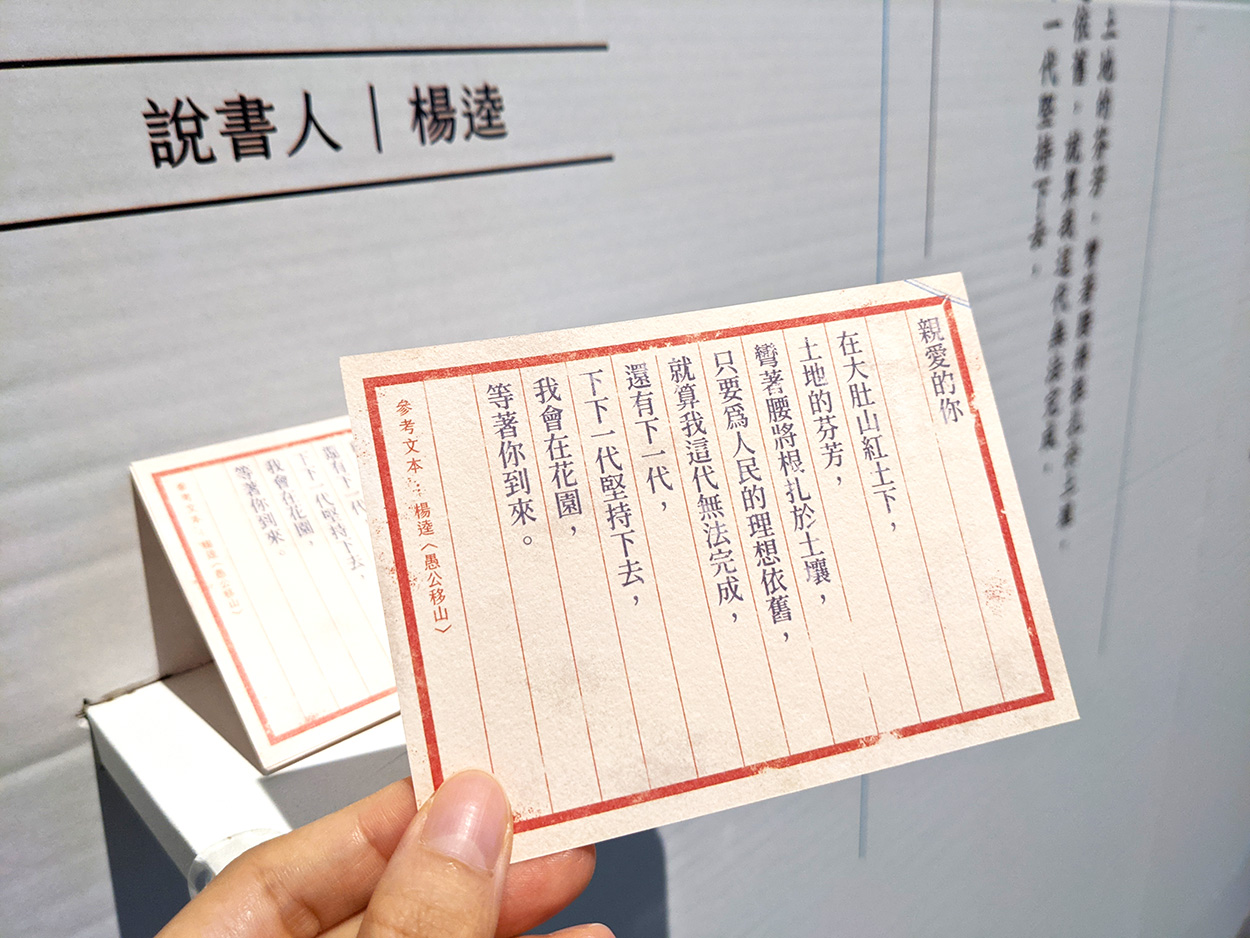
Real art speaks to the general public; art that only a few people understand is not real art. Real art resonates with people and touches their heart.
—Yang Kui, "Art For The People"
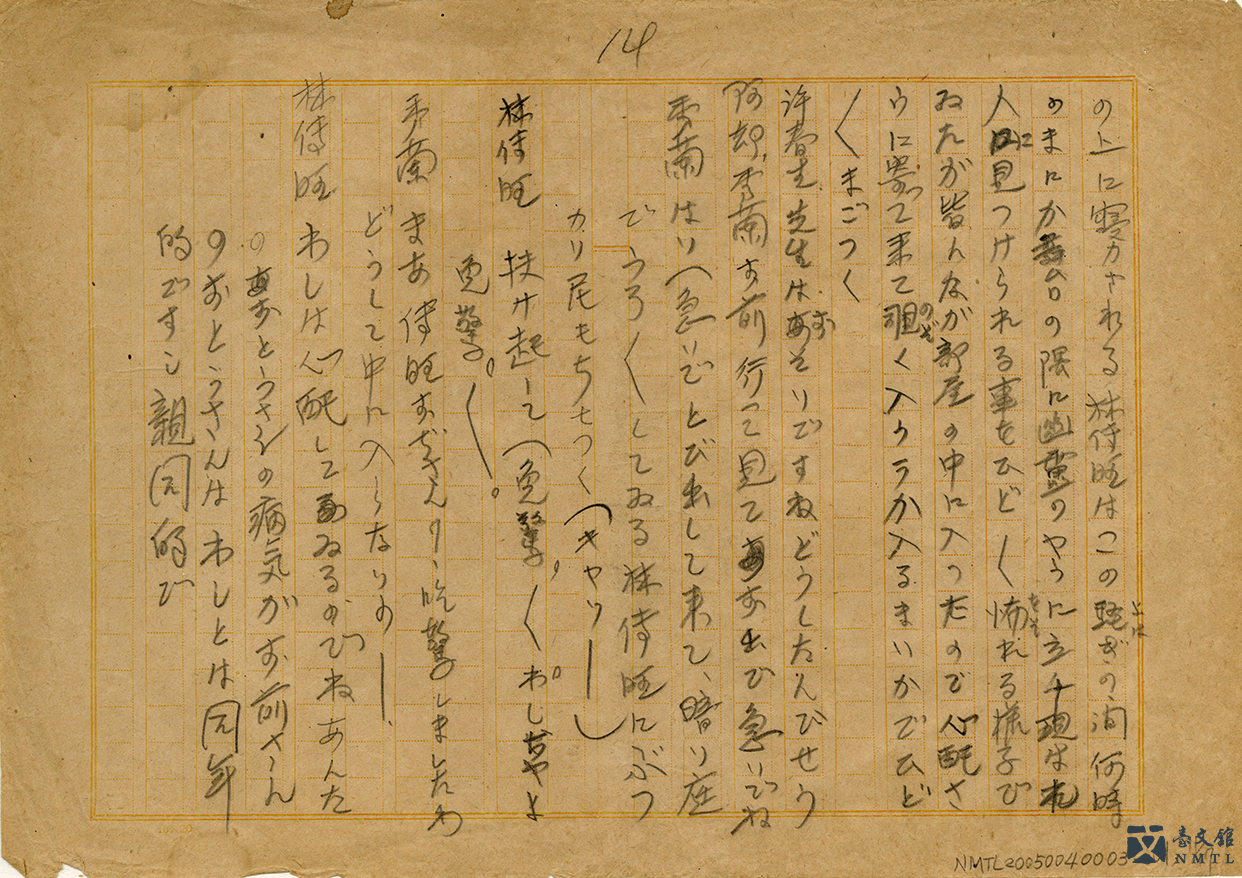
ღ Yang Kui "Eradicating Dengue"| Yang Kui's "Eradicating Dengue" was published in No. 1, Vol. 8 TAIWAN TRIBUNE in January 1943. This piece is suspected to be the remaining first draft of the first scene. The first scene describes how Lin Da-tou secured a high-interest loan of 200 yen from Li Tian-gou to pay for his son's bride price but is unable to repay the loan. During the harvest season, Lin Da-tou falls ill with dengue fever. To make things worse, his daughters also become ill. Lin Chuang-wang, who works for Li Tian-gou, also feels bad about having to collect money from them after becoming aware of their situation.(Donated by Yang Jian)
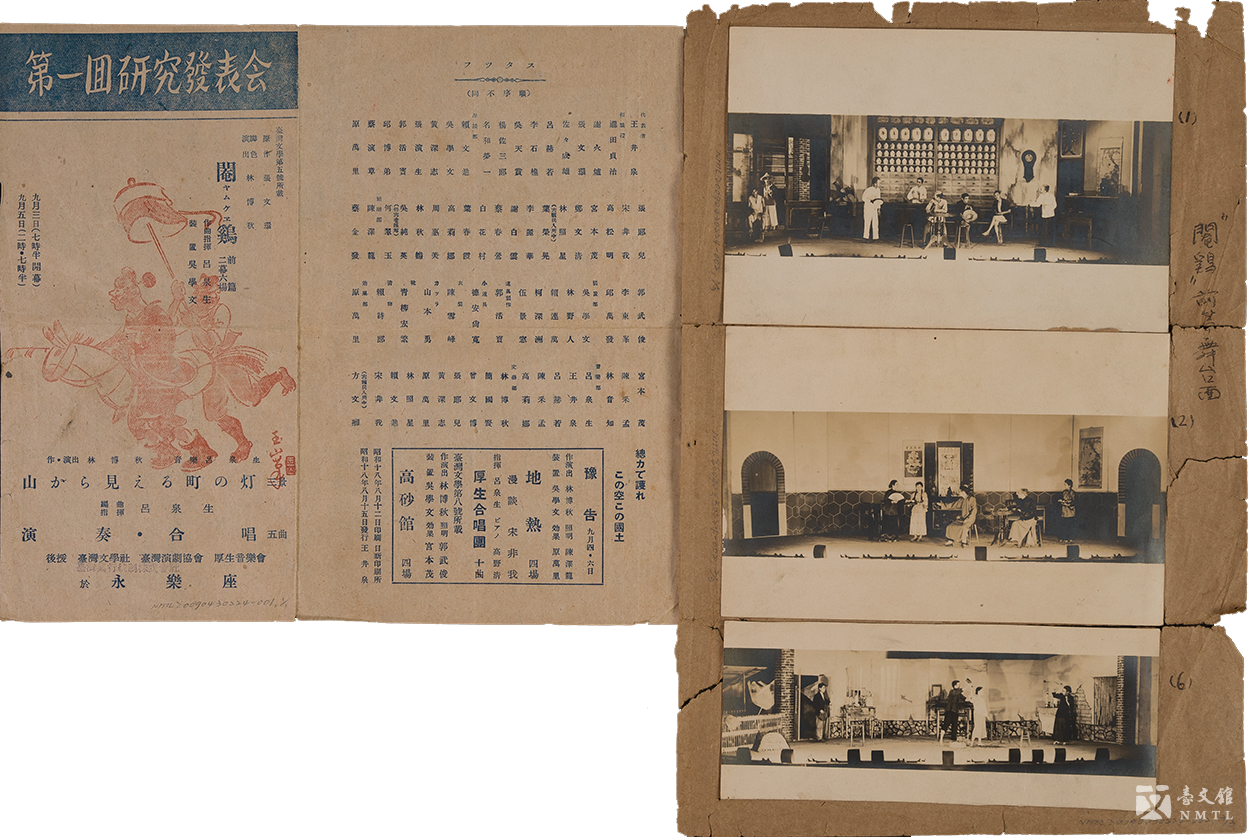
ღ The Program for the Play THE CAPON (6th scene, act two, prequel) & THE CAPON Performance Photos| On September 3rd and 5TH, 1943, the prequel of THE CAPON (aka CASTRATED CHICKEN) was performed in Taipei. The program shows that the original writer was Zhang Wen-huan, and the casting director was Lin Tuan-chiu; the music was composed and conducted by Lu Quan-sheng; the stage setup was done by Wu Xue-wen. The program also notes the responsible person for the show, the consultant, and the list of actors. There were several important people active in the literary and art scenes in the 1940s: Wang Jing-quan, Lu He-ruo, Wu Tian-shang, and painters, including Li Shi-qiao and Yang San-lang.
In the photo, one can see details such as the layout of the house, props, and curtains that capture the atmosphere of Zhang Wen-huan's novel.(Donated by the family of Lin Jin-peng)
Even so, whenever a vibrant festival takes place in the village, Yueli's mind churns. "What is this all about?" Even she is confused. Yet, she is compelled to feel worried. As to the ceremony this time, she feels that her feelings of imbalance have been seen through. When she was invited to act as a performer in the festive performance for the parade, she said yes immediately.
—Zhang Wen-huan, "The Capon"
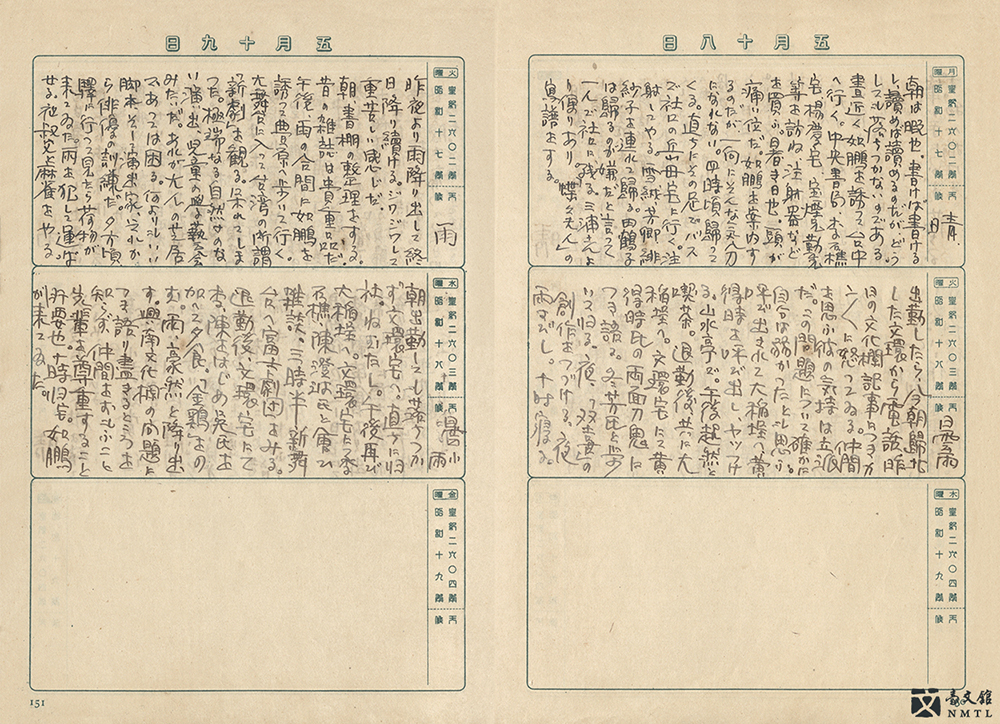
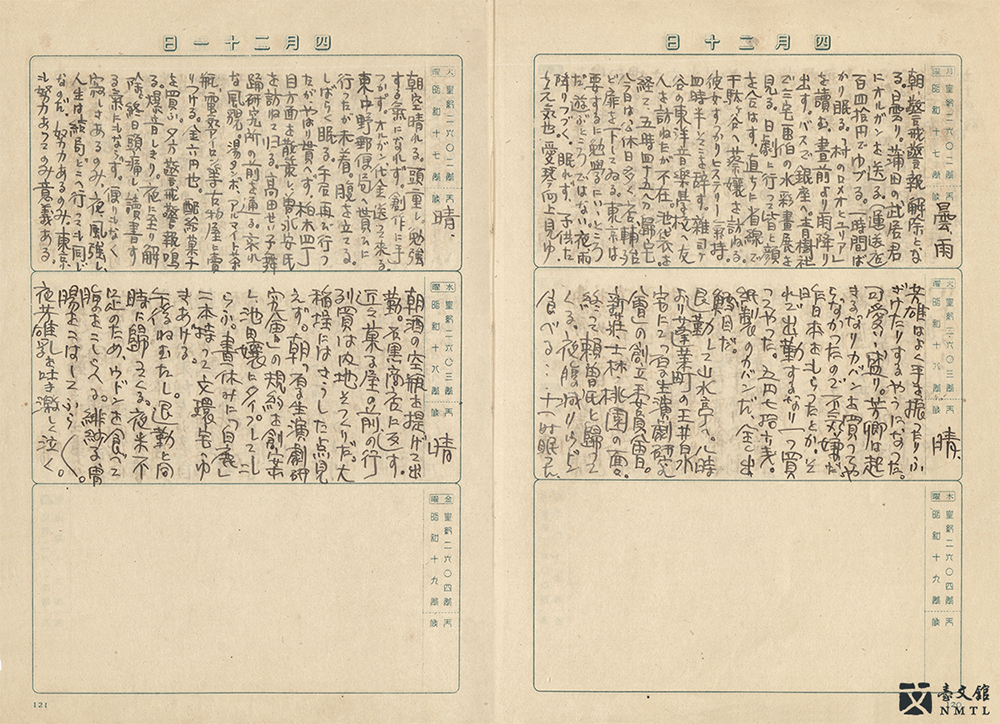
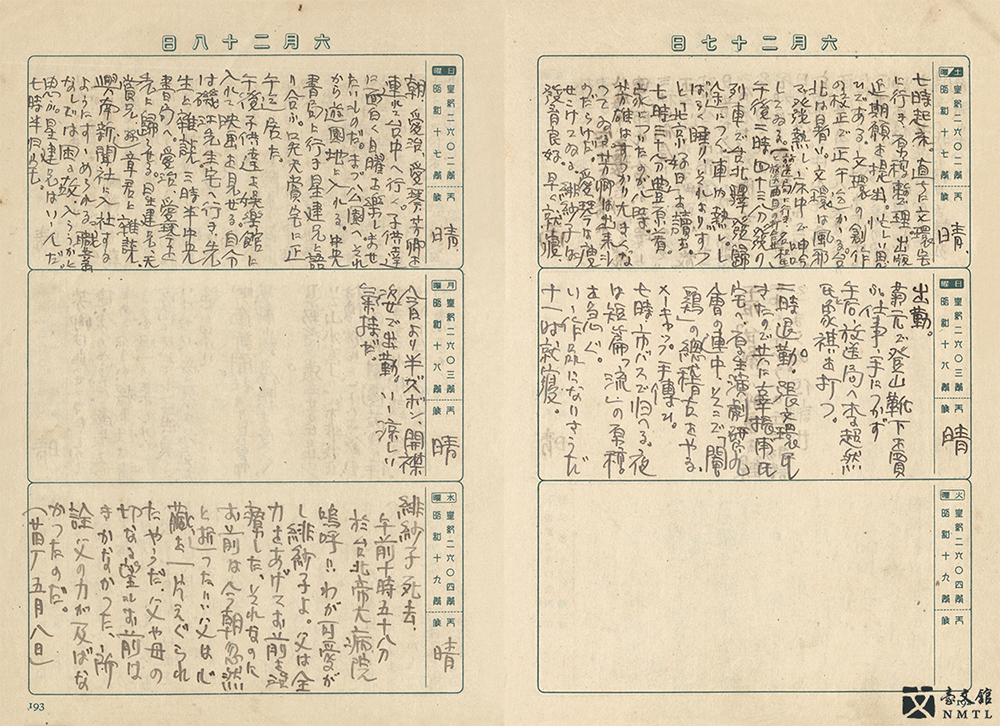
ღ DIARY OF LU HE-RUO| This diary was used for three consecutive years and is the only surviving item directly associated with Lu He-ruo. It contains entries from when Lu He-ruo was living in Tokyo and Taiwan from 1942 to 1944. The entries include his thoughts on novels, scripts, movie reviews, theatre reviews, and book reviews, and family life. The dairy shows the activities held by the art, music, and theatre worlds in Taiwan and their interactions in the 1940s.(Donated by Lu Fang-qing)
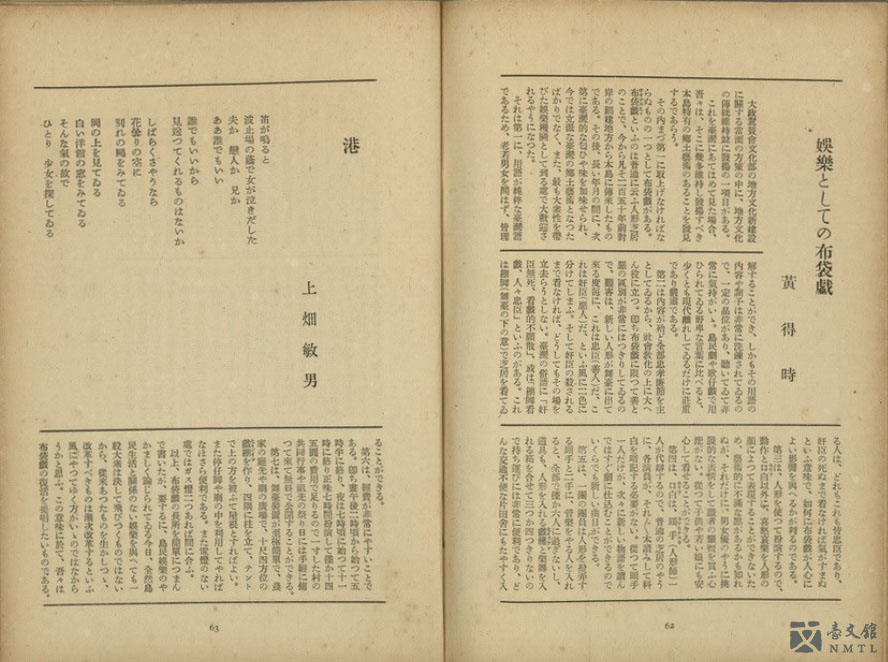
ღ Huang De-shi's "Glove Puppetry as Entertainment" No. 1, Vol. 3 LITERARY TAIWAN| Huang De-shi's "Glove Puppetry as Entertainment" states the seven merits of promoting glove puppetry: 1) most people can understand it because it's performed in Taiwanese; 2) the stories are mostly about moral virtues, which have a positive social impact; 3) interactions between men and women are acted out using puppets, so parents don't have to worry if they bring their children; 4) it only requires one person to manipulate the puppets and say the lines; 5) puppets are easy to carry; 6) it doesn't cost much; 7) the stage set up is easy.(Donated by Long Ying-zong)
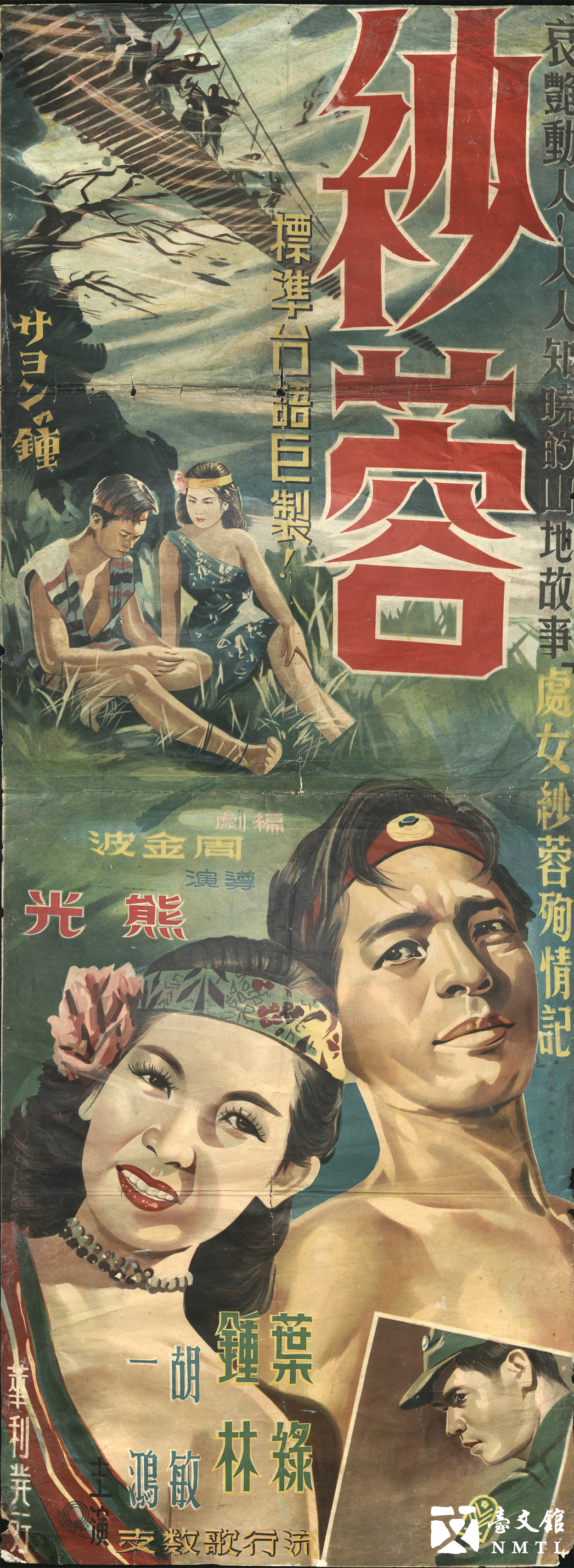
ღ Sayon's Bell (poster)| SAYON'S BELL, a Taiwanese-language film, was released in 1958. Zhou Jin-bo was the screenwriter. The story was based on a piece of news about an Atayal girl who helps a Japanese teacher carry his luggage but accidentally falls into water and drowns. The film was released during the promotion of Japanese national culture in Taiwan (Nipponization), so it was widely promoted and reported. In 1942, the government-general of Taiwan entrusted a film company to make it into a film. In 1958, Zhou Jin-bo adapted the original Japanese screenplay into a Taiwanese-language film.(Donated by Zhou Zhen-ying)
🎬 AROUND TAIWAN
In 1934, the government-general entrusted a Japanese team to make a film about Taiwan. This is a clip of the May 13th (lunar calendar) City God Ceremony. The film shows elements of the local folk culture, including the Seventh and Eighth Masters and glove puppetry, and records the sounds of the troupe and procession at the time.(Provided by National Museum of Taiwan History)

